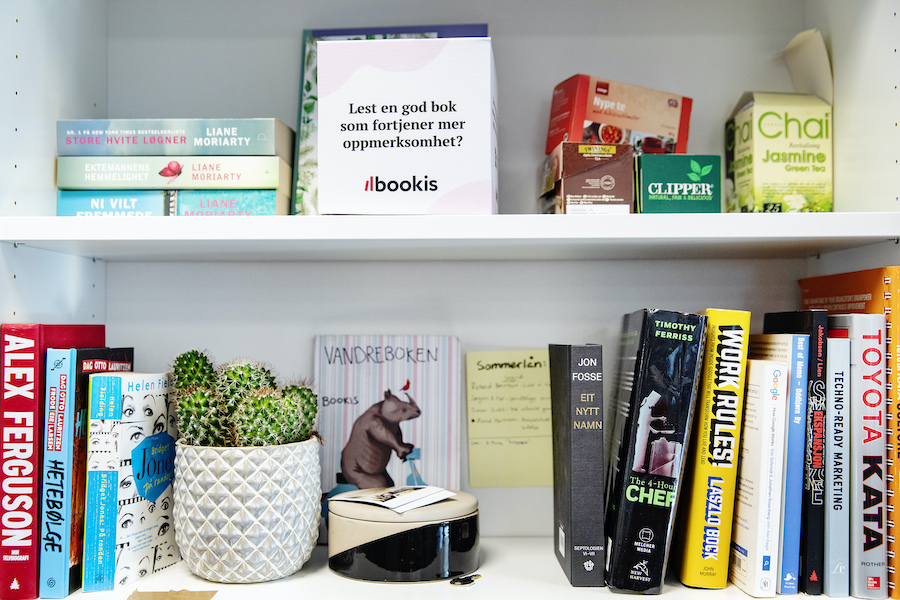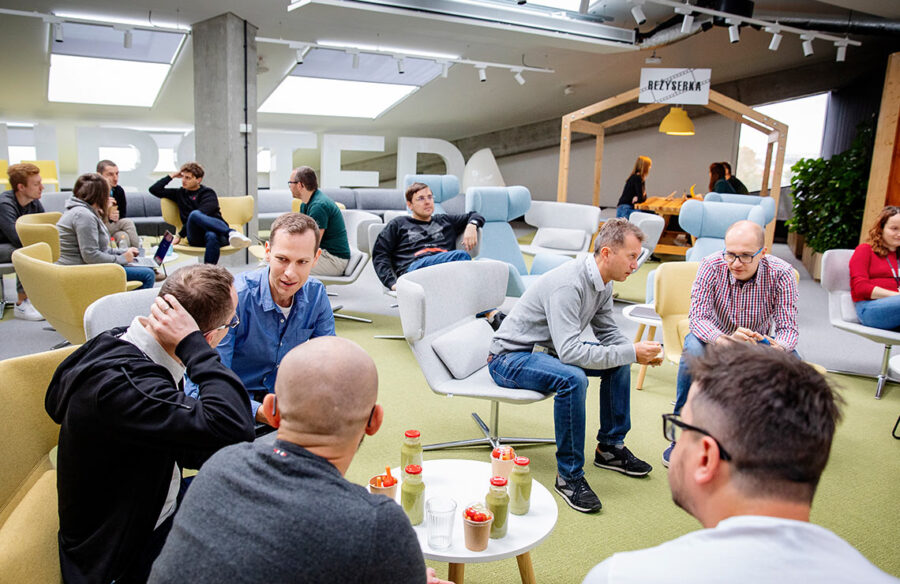Making used book sales painless

Lasse and Arne-Morten met in the armed forces, years before they started Bookis together.
Making used book sales painless
Bookis is a rare success story of literary entrepreneurship. In just a few years, the company’s online marketplace for used books has accumulated the widest selection of books in Norway, offering four times more Norwegian titles than its closest competitor.
With almost 300,000 users and more than a million titles, Bookis has established itself as an online treasure chest for book lovers in Norway and Sweden. On top of that, it has managed to shake up the old book publishing oligopoly. That doesn’t mean it’s achieved its goal, however – far from it.
But first, we need to go back to the beginning. Although the company wasn’t founded until 2017, we have to go all the way back to 2008 to find the true beginning of Bookis. More specifically, to the Norwegian Army Officer Candidate School in Indre Troms in northern Norway.
Because it was there, between the gun smoke and green army camouflage uniforms, that Lasse Brurok and Arne-Morten Willumsen first met.
A friendship that has lasted
“In the armed forces it doesn’t take long to get to know people on a deeper level. I think we both realised pretty quickly that this was a friendship that was going to last”, says Lasse.
The two young men served alongside each other for a couple of years before Arne-Morten packed his bags and moved to the United States to study finance. Lasse continued his career in the armed forces alongside working as a street artist. Even though they lived on different continents, their friendship remained strong.
When Arne-Morten returned to Norway a few years later, he got involved in a number of startups. In one of them he was responsible for the company accounts, and was tipped off about a book on Norwegian accounting rules. Because it was so expensive, he decided to find a used edition. That turned out to be more difficult than he expected.
“I came across sellers who never turned up at the agreed time, and there was no easy way to pay. It was shocking to see how difficult it was to buy a used book. In the States it was easy to buy used books via Amazon, but a similar service didn’t really exist in Norway.”
An idea began to form in Arne-Morten’s head. Recycling and the circular economy were more popular than ever before, and e-commerce in the Nordics was growing by as much as 20 percent annually. Could it really be that hard to set up a one-stop shop for used books?
“For people to even bother to sell a used book, the threshold has to be very low. No one is willing to spend a lot of time and energy on earning a hundred-krone note”, says Arne-Morten.
His idea gradually evolved, and in 2016 he shared it with Lasse over dinner. Before the evening was over, they had officially founded Bookis. Since that day they’ve never looked back.
In the beginning there was a lot of testing and failing. The first proper experiment involved turning a class of students at the BI Norwegian Business School into a concrete case. All the useful input they got from the students was used in the further development of Bookis.
“We used lean methodology and based our work on the build-measurelearn model. Through testing and failing, we gradually understood what worked and what didn’t”, says Lasse.
After a while they found themselves facing their biggest challenge so far: how would they get the books from the seller to the buyer?
Helthjem became a turning point
“The big turning point came when we called an acquaintance who’d recently got a job at Helthjem. They had just started to develop a new service called Me to You, that would make it super easy to send packages between private individuals. What an amazing stroke of luck!” says Arne-Morten.
Helthjem and Bookis developed their services in parallel, and launched them simultaneously just before Christmas in 2017. While everyone else slept during the dark winter nights, Helthjem’s couriers collected and delivered used books all over the country, from door to door.
“Getting the agreement in place with Helthjem was undoubtedly the most crucial factor to our later success. It’s like the stars were aligned”, says Lasse.
Since then, Bookis has worked continually on improving and simplifying its user experience. Integrating a function to enable customers to scan the barcode on the books they want to sell was a milestone. This allows Bookis to find all the information about the books and enter it into the system automatically.
To expand its selection, Bookis has also started selling new books at competitive prices. But it is still the used books that make up most of the inventory. The used books are also sold at a fixed price, which means that sellers don’t have to deal with hagglers.
It’s up to the buyer and seller to decide whether they want to meet in person or use Helthjem’s delivery service. If they choose Helthjem, the buyer pays the shipping charge.
“Sellers perceive us as a marketplace, while buyers perceive us as a regular online book store”, says Arne-Morten.
One thing that shocked Arne-Morten and Lasse when they entered the book industry was that Norwegian authors receive only 15 percent royalties on sales of their books while the publishers rake in the rest. On top of that, it is the publishers that own the copyrights. Arne-Morten and Lasse thought this was a really bad deal.
“We think the conditions for authors are bad enough to start with, and that they also deserve to earn money on the books that are sold on. So we developed a function for this. Buyers on Bookis can opt to add an amount of their choice as a royalty to the author when they buy a used book. So far we’ve collected more than NOK 700,000 for Norwegian authors”, says Lasse.
A good culture is most important
Product development and the business side are perhaps the two key aspects for many young entrepreneurs, but for Arne-Morten and Lasse, the top priority has been to build a good company culture. And they thank the armed forces for that. They describe the Norwegian Army Officer Candidate School as a kind of crash course in leadership.
“Our philosophy is simple: look after the staff and solve the task – in that order. Our goal has been to nurture a good work environment with a high level of psychological safety. Without a healthy and positive culture based on trust, we will never succeed”, says Lasse.
In a safe space, there’s nothing dangerous or frightening, and that includes talking about your own mistakes or showing your vulnerability.
“We often discuss our own mistakes and what we have learned from them”
“Lasse and I have always been good at challenging each other, even in front of colleagues. But it’s done out of love, and out of a shared desire to succeed. And we often discuss our own mistakes and what we have learned from them. More leaders should be better at showing that they’re just humans, too”, says Arne-Morten.
And no one in Bookis gets applause for working long hours.
“We want people to have a healthy life-work balance. We come and go at normal hours, and when we leave work, we turn of all the job-related notifications on our phones. There’s nothing cool about working yourself into the ground or sending e-mails to everyone at all hours”, says Lasse.
They’ve also introduced meeting-free Wednesdays and are happy if colleagues don’t reply to e-mails or messages on Slack during the workday. “That just
means that they’re focusing on their tasks and are not letting themselves be interrupted by all those time stealers”, says Lasse.
And it seems that both the business model and their leadership philosophy has worked; after only four years, the arrows are pointing upwards for Bookis. But where do they go from here?
“We’ll keep banging away, and we will definitely work closer with authors in the future. We’re not quite ready to reveal our specific plans just yet. The only thing I can say for sure is that it will be totally cool! And that Bookis will be a well-known name on a lot more people’s lips”, says Arne-Morten.
This is Bookis
Norwegian launch: December 2017.
Swedish launch: September 2020.
Number of users: 285,000 (70,000 in Sweden).
Number of employees: 26.
- Bookis offers a four times larger assortment of Norwegian titles than its competitors.
- Offers a mix of fiction and non-fiction titles.
- The first in the world to launch a royalty program for used books.
- Aims to expand into new markets.
- Has a revenue of over 50 million NOK in 2021.
- Schibsted made an initial investment in Bookis in 2019, and today owns 29.3 per cent of the company.

Linda Christine Strande
Communications Manager
Years in Schibsted: 3
With the power to save the climate

When eight of the world’s largest seafood companies got together they realised no one would benefit from polluted, depleted oceans – so they decided to change things. This is one of the stories told at the executive programme for CEOs.
With the power to save the climate
Greta Thunberg is not the only one listening to the science. CEOs of companies that generate almost half of Sweden’s GDP have returned to the classroom to learn about climate science and action. When deep insight about the climate crisis reaches this level of decision-making, real change can come about.
It’s thanks to Lisen Schultz that the Swedish CEOs decided to clear time in their busy schedules to take the course. In 2018, she transformed what began as an annual event into an executive programme for CEOs at the Stockholm Resilience Centre at Stockholm University.
Standing alone on the stage under the strong lights, she felt the conviction grow. The worst thing had already happened to her, and so she had no fear left. Her husband, and father of her three children, had died in a bike accident in the mountains outside Nice, and now she stood there with all eyes on her. The room was filled with Sweden’s top business leaders, invited journalists and researchers, who had come to discuss sustainability and what could be done to speed up the transformation.

In memory of her husband, Lisen Schultz wanted to shape a business sector that respects the planetary boundaries and nurtures human potential. He had been editor-in-chief of a number of financial newspapers, and was passionate about issues like gender equality, diversity and sustainability in business. As a sustainability scientist at the Stockholm Resilience Centre, Lisen saw a path along which his work could be taken forward.
Looking for a stronger impact
Amidst all the chaos that ensued from the accident, she created the foundation that bears his name: the Pontus Schultz Foundation for more humane businesses. But as the climate crisis accelerated, Lisen wanted the foundation to have a stronger impact on action. And even though her grief had caused her to doubt, it all started there on a stage in the glare of a single spotlight.
No sooner said than done; one day in early autumn, the taxis rolled up and Swedish business leaders – major shareholders like Jacob Wallenberg, Tomas Billing, CEO of Nordstjernan, Henrik Henriksson, CEO of Scania and Axel Johnson’s Pia Anderberg – entered the researchers’ domain and took their seats. As a whole, the class generated a substantial share of Sweden’s GDP and accounted for CO2 emissions twice the size of Sweden’s. It was mind-boggling, but the power of science gave Lisen a new glimmer of hope.
“With lectures being given by world-leading researchers, the message would be clear and no one would shy away from ruffling a few feathers, I knew that. But I had no idea whether or not it would work.”
“The planet has financed our way of life. Now the invoices are arriving.”
Professor Johan Rockström took the classroom floor: “The planet has financed our way of life. Now the invoices are arriving.” He then proceeded to describe the anthropocene – the geological epoch in which humans shape the climate conditions – and the safe operating space for humanity.
“Four planetary boundaries have already been crossed, while others are dangerously close to their respective tipping points. The situation is dangerous but we can still change direction”, he explained. Members of the audience started shifting in their seats, and that was before Kate Raworth, economist and creator of Doughnut Economics, took the stage and insisted that economic theory had to be adapted to the planetary boundaries; a radical message that challenged the idea of infinite growth and maximum profit.
Not everyone agreed, and loud discussions ensued, but eventually the discussion shifted towards what could be done. Participants identified actions they could take in their companies, but also who else they could influence in order to achieve zero emissions, such as suppliers, employees, customers, competitors, investors and politicians. Companies can influence the world’s development, and the course participants realised they were not making the sustainability journey alone. The nightmare soon became a dream.

It needs to be In a company’s DNA
“You can’t base a transformation on a separate sustainability strategy. Clear goals are all well and good, but sustainability must be in a company’s DNA, corporate culture and governance. Changes will only last if they’re value-driven; only then will employees get onboard”, said Henrik Henriksson, CEO of Scania. The others nodded in agreement.
So far around 50 or so CEOs and owners – and even Crown Princess Victoria – have been trained by Lisen Schultz and her colleagues. But, once they’re armed with new knowledge about circularity, resilient systems and planetary boundaries, what can business leaders do? What obstacles can they overcome together? And what system of governance could accelerate this sustainable transformation?
According to Lisen Schultz, there’s a limit to how much a company can achieve single-handed to, say, reduce emissions or recycle resources. And the playing field is often tilted towards unsustainability, since many business activities don’t have to bear the costs they impose on society.
“This is where politics plays a big role at global, EU and national level; there’s no getting away from it. But companies of this size can influence politicians, especially if they join forces. That power grows strong during the course”, says Lisen.
The regulations are often decided by the politicians, and they can be about introducing bans, subsidies or taxes and duties aimed at steering the market away from whatever is fossil and resource-intensive and towards circularity and sustainability. EU’s emissions trading system and the carbon tax levied in Sweden and 26 other countries is one example. The fact that New York City pays landowners around the Hudson River to have their trees and wetlands clean the water that runs into the city taps is another one. In other words, governance systems can be large-scale and comprehensive, as in the case of the EU’s taxonomy regulation, which benefits sustainable businesses or, as in the case of New York City, can work on a smaller scale in a specific area.
In the near future the discussion will become even more forward-looking
Of course, not everyone is convinced, but in the near future the discussion will become even more forward-looking. What are the barriers to the sustainability transformation which owners and customers are slowly but surely demanding? What can promote and accelerate the green transformation, and what leads to reluctance, stagnation and “business as usual”?
“Harming the planet should be expensive, but it is not”, says Lisen Schultz.
“Having to make financial concessions often leads to relocations, but there are cases where actors actually succeed in changing the playing field simply by working together. This may sound rather banal, but bear in mind that ten companies control almost three quarters of the world’s oil reserves or that five companies account for 90 percent of global palm oil production. Our future lies in the hands of a few companies.”
She sees the situation as serious, but just as it’s possible to see which companies are actually creating pollution, it’s also possible that they can be part of the solution. Because if the five companies that own almost all of the world’s palm oil production were to decide not to sell palm oil from chopped-down rainforests, the whole playing field would change overnight. And while the world’s three biggest carbon emitters – China Coal, Saudi Aramco and Gazprom – are unlikely to adapt as long as they’re earning money with the current model, there are others who are taking a stand nonetheless. The Danish company Ørstedt previously supplied gas and oil but decided that offshore wind was the future for itself and for the planet, and reduced its emissions by 86 percent over ten years. And its profits remain high and are continuing to grow.
13 companies made an agreement
Carl Folke, professor and founder of the Stockholm Resilience Centre, gives lectures in the course and has, among many other things, led a ground-breaking study on the global seafood industry. Most of this team know that a growing global population and a changed climate make onshore crops even more unpredictable. But most people don’t realise that the world’s oceans feed three billion people. Unfortunately, this food source is also threatened by overfishing, acidification, pollution and algae blooms, leaving the fishing industry under threat on multiples fronts.
Carl Folke and his fellow researchers have shown that 13 companies dominate the global seafood industry, yet they all rely on the same resource, so if they could sit down and talk to each other, would they manage to reach agreement on a form of exploitation that would benefit everyone while still being more or less beneficial to the oceans? No sooner said than done; the researchers succeeded in gathering eight of the biggest seafood companies in a neutral place where they could discuss the situation together. It suddenly became clear to everyone sitting around the table – who came from different countries and cultures – that there was only one way forward and that they all faced the same threats of pollution, acidification, antibiotic resistance and overfishing. But the biggest insight was that, together, they could make a difference without removing the competition between them. They could quite simply agree to, for example, improve working conditions, exert influence on laws and regulations, and make it easier for consumers and authorities to track fish from vessel to table and how they are caught, which would reduce the risk of poaching. From that point on, it was a short step to setting sustainability goals, taking responsibility for supply chains and avoiding highly vulnerable areas. Because no one benefits from polluted, depleted oceans.
Despite all her knowledge about the global situation, Lisen Schultz remains an incurable optimist, and she believes that climate communication represents an untapped resource.
“Martin Luther King didn’t say ‘I have a nightmare’; instead, he painted a vision of the future where black and white people lived as equals. The same logic can be applied to climate communication. Most of us want the best for the planet, for their own sake and for that of their children, but we need help to achieve that.”
It’s about setting scientifically informed goals, taking control of our climate footprint and working locally. It’s not about adopting an anorexic lifestyle; it’s about doing whatever we can at every opportunity and cooperating on reaching our goals within the planetary boundaries.
“It is in business and industry that those heroes are found”
The business leaders in the classroom in Stockholm also got a strong message from Nigel Topping, appointed by the British government as High-level Climate Action Champion, tasked with raising industrial climate ambitions in the preparations for COP26:
“Every disaster film has heroes who refuse to give up and who find a way forward. When it comes to the climate, I’m fully convinced that it is in business and industry that those heroes are found”. According to Topping, the Paris Agreement came about partly through the united voice from hundreds of leading companies who supported an international climate agreement.
Most business leaders agree that goals need to be realistic and time-bound. But at the same time, ambitious goals are pushing the boundary of possibilities, in the same way John F Kennedy did, when he decided that a moon landing should happen. This clear goal and a solid pot of money released creativity and mobilised initiative; the impossible became possible.
Lisen now sees parallels between her own story and personal loss, and how all of us now need to adapt to a new reality, however painful that may be. But to be able to do it, we must have a vision, a goal and a plan that is sustainable, one that enables us to take a first step on the journey, together. Because that’s how we humans work. Life always finds a way.

Erica Treijs
Reporter, SvD
Years in Schibsted: 20
Protocols, tigers and unicorns

Protocols, tigers and unicorns
2021 is a time of change for entrepreneurs raising venture capital, and for the firms providing it. For founders, there has never been a better moment to start a company and seek funding. Dan Ouchterlony, EVP Financial Services and Ventures, looks into an exciting future.
Venture capital is booming. In the third quarter of 2021, a whopping 158.2 billion USD was invested into start-ups at various stages, according to CB Insights. This is more than double the investment compared to the third quarter 2020 (which itself was a strong quarter!) and the highest number on record for a single quarter.
The driver was the volume of large rounds, totalling 409 investments of more than 100 million USD, up from 173 in Q3 2020. However, at the end of the funnel, exits have only increased 13 percent in 2021, as compared to 2020. Thus, an increasing amount of wealth is tied up in start-ups.
This prompts many questions. What are the driving trends in the industry, and why is interest booming? Who are the movers and shakers? And what is happening on the fringes? Is the rising tide lifting all boats, or are some players at risk of losing out?
Masayoshi Yasumoto was bullied as a child. Despite being third generation Japanese, he was considered ethnically different. In his adolescence he agonised over his identity to the extent that he seriously contemplated taking his own life. Today he claims, somewhat credibly, that he is the Rothschild of the Internet era. But you know him as Masa-san – the CEO of Softbank and chairman of The Vision Fund, the world’s largest venture capital fund.
Masa and The Vision Fund came blazing on the venture capital scene on 20 May 2017, with the announcement that they had closed 93 billion USD of commitments to the fund. Compared to the 153 billion USD of venture capital invested in 2016, this was a staggering number by all accounts. By September 2019, all the funds were deployed, except a small reserve, and venture capital was changed at its core.
The Vision Fund changed the game by being more aggressive than other venture capital firms, both in terms of how much capital they deployed into their investments and by threatening to fund rivals. Established venture capital funds lost out on deals, as Masa-san was willing to raise valuations, and effectively bought his way into deals using both carrot and whip. Seen as a king maker in the segments they entered,founders and CEOs jostled to stay behind, rather than in front of, what Dara Khosrowshahi, Uber’s CEO, famously called “the capital cannon”. What happens if Softbank funds my rival, wasn’t a rhetorical question.
The canon has not reloaded
Softbank and The Vision Fund also played a different game in the public arena. Whereas many established venture capital players relied on building relations, understated communication, and thought leadership in their industries, Masa-san went on stage with slogans like “happiness for everyone” and slides with pastel-coloured unicorns and golden geese.
The Vision Fund’s capital cannon has not been able to reload, however. And due to the poor financial results (so far) of Vision Fund 1, Vision Fund 2 has shrunk dramatically in comparison. With the aim to raise 108 billion USD, the fund has only raised 30 billion USD to date, all of which is committed from its owners at Softbank.
Was it then a historical blip on the radar? Some of what happened might be told as a cautionary tale for the next generation of venture capitalists during fireside chats. But one thing is for certain. Masa-san is not finished. He is not a stranger to failure after losing some 70 billion USD of personal wealth in the dotcom crash, and rising taller from adversity, as exemplified by changing his family name from their Japanese-assumed name of Yasumoto back to his family’s original Korean name Masa Son.
One thing that seems to have permanently changed in the wake of The Vision Fund is the speed of execution in large deals. But today, the velocity of deal making is no longer the hallmark of the “Unicorn Hunter”, but that of the “Tiger”.
But today, the velocity of deal making is no longer the hallmark of the “Unicorn Hunter”, but that of the “Tiger”.
Tiger Management was one of the largest hedge funds of the 1990s. After a bout of poor performance, it closed in 2000. Out of the ashes of the fallen fund, some 30 young managers in the team were staked to start their own hedge funds. One of them was Tiger Global Management – the Tiger that we know and talk about in the venture capital business today.
Tiger is, so far during 2021, closing about 1.2 deals per business day. This speed is unusual even for the predator: according to Crunchbase, 240 investments have been made as of 11 October 2021, up from 80 deals during the whole of 2020, and 86 deals in 2019, during the same period. In other words, Tiger is running three times their already high speed.
Pundits are commenting that Tiger is “indexing” the venture capital market, in a move characteristic of a hedge fund. Not a cannon perhaps, but a machine gun. The theory goes that if they spread their bets widely enough, they will hit enough success cases to generate returns.
What does this mean? First, let’s look back. The venture capital business is traditionally based on long-term relationships, which in and of itself means investing a lot of time per deal and trying to add value after the deal is done. It’s a model taken “to the next level” by Andreesseen Horowitz, who famously built the largest support staff in the business and financed it by forfeiting their own management fee. Despite Tiger’s extremely big staff, doing and supporting 240 deals in three quarters is just not sustainable on this conventional model. So how does Tiger do it?
Tiger does not build relationships
They do it by effectively employing the opposite of the conventional wisdom. Tiger does not build relationships in advance of sending term sheets. Tiger does not want a seat on the board. Tiger does not want to do heavy due diligence. And Tiger does not try to support you operationally after the deal. This indexing of bets has already happened to some extent in the earlier stages, where organisations such as Ycombinator and 500 Start-ups have tried to spread their bets very widely by speeding up investing. But with the sheer amount of early-stage rounds happening, the index will never be even close to complete. Tiger, on the other hand, has a real shot in the later stages.
The result of Tiger’s approach for founders is better, faster and cheaper capital, according to Everett Randle of Founders Fund. Start-up founders can spend less time raising funds and can for good and for bad, take capital without giving up control. This is attractive for many, and only the biggest, most successful venture brands will survive long-term with the established relationship model, according to Everett. The mid-sized firms will be squeezed by Tigers and the like, who are forging ahead with extreme conviction.
For venture capital this means many more people want to get involved
Another phenomenon on the rise, both in general and especially among the young, is decentralised finance. Technical terms such as blockchains, crypto currency and non-fungible tokens (NFT) are becoming mainstream. There are two things going on at the same time: First, access to and interest in capital markets are on the rise generally, boosted by players such as Robinhood and the get-rich-quick FOMO in the longest of bull markets. Second, entirely new technologies that decentralise and democratise finance – defi in short – are on the rise. One example is investor-entrepreneur from generation Z, Jacob Clearhout, left his firm to “do a start-up” at the intersection of VC and defi. In a fantasy football game for start-up shares called Visionrare, fake shares are minted as NFTs, sold for five USD each, and then made investable in a game of I-told-you-so.
For venture capital this means many more people want to get involved, both as venture investors, builders, speculators and commentators. One particularly interesting topic is the attack on the existing power structures in venture capital. As an industry that typically builds on apprenticeship, personal networks and significant personal wealth, it is somewhat uncomfortable to have young talent discuss tips for “breaking into VC”, “discrimination of non-white founders”, and why it is time to “ban the warm introduction”. According to Del Johnson, who launched the proposed embargo, the network-based approach of personal introductions is not only anti-founder and discriminatory, but even worse, it leads to subpar performance. Why? Because you miss the opportunities outside your network.
What is even more uncomfortable for many are defi structures that emulate and disrupt the venture capital firm itself. On the bleeding edge of development there are venture capital initiatives on the blockchain, structured as decentralised autonomous organisations (DAOs). Either these new structures appear for a special purpose, such as when the digital artist Pplpleasr auctioned off one of his works. And the winning bid was placed by some 30 individuals who organised on social media, gathered the funds, and formed a joint investment DAO in the matter of days. Incorporating an investment firm is a much slower process.
Votings are held in public
Pleasr-DAO has since invested in art by Snowden and Wu-Tang Clan’s album Once Upon a Time in Shaolin, which they bought from the US Department of Justice, who in turn seized it from original buyer, pharma profiteer Martin Shkreli.
Another type of DAO can be a more general “VC on the blockchain” structure, such as when Singaporian cryptoexchange Bybit launched the 540 million USD investment vehicle Bit-DAO in September 2021, with external funding from Peter Thiel and Founders Fund among others. To be clear, this is a half billion-dollar VC firm in a protocol where partnership meetings (voting) are held in public, investment proposals are openly scrutinised (in a forum) and the governance model itself is defined by code.
The idea is not new. In April 2016, the first DAO named “The DAO” was launched, raising about 150 million USD worth of crypto currency from more than 11,000 investors through crowdfunding. At the time around 14 percent of all Ether in issue was owned by The DAO, with plans to become a fully decentralised venture fund. However, the code running this particular firm was flawed, and after losing a third of the capital to a hack, The DAO was delisted, and the project was disbanded. To recoup the losses, the actual blockchain underpinning The DAO was split in two, and the transactions were annulled. If not for the false start, many believe DAOs would have had a much more prominent role today.
As if this wasn’t enough, traditional venture capitalists also face a new generation of investors who are starting out their careers with a new focus and modus operandi, which just might be the future.
Meagan Loyst, investor at Lerer Hippeau is the founder of Gen Z VCs, a network of more than 10,000 who identify with the community of investors and entrepreneurs born after 1995. On her Medium page she published that the number one trend this group is interested in is the creator economy (Roblox, TikTok, UGC, etc.).
Their takeaway is that people see the path to becoming a creator as more institutionalised, and from a young age. Is the same happening to VC in general? The lines between entrepreneurship, investing and creating are certainly blurring. Many entrepreneurs are also angel investors and vice versa. Young VCs are obviously not afraid to network, entirely on the outside of the traditional pipelines of the firms; they are not afraid to make their voices heard; and topics of sustainability, inclusion and equal opportunity are on the rise.
If you are a venture capital firm today, your cosy corner of the market is under attack from many sides: Hedge funds trying to index your asset class “from above”, angels and young VCs banding together online, and blockchain tinkerers trying to democratise your privileged access “from below”. And there you are stuck in the middle. What will you do?
You could adapt and beat Tiger at their own game, like Sequoia China seems to have done. While Tiger takes the media headlines, the semi-independent Chinese arm of industry titan Sequoia made ten more deals in Q3 2021 than Tiger did, according to CB Insights. Does this mean entrepreneurs who take Sequoia China on board as investors will not get the gold standard support of Sequoia?
Only time will tell. In late October 2021 Sequoia announced they will go even more in Tiger’s direction by dropping the traditional a 10-year fund-circle, staying post IPO in the most promising companies. In practice they are becoming a hedge fund.
You could also double down on the current strategy, like it seems Andreesseen Horowitz has done in the crypto arena, by building out its investment and
support teams with roles such as crypto counsel, protocol specialist and crypto network operations. At one point, A16Z Crypto recruited so fast, it became a Twitter meme. According to the Information staff has almost tripled in four years.
Who will succeed? Will Tiger be able to show good returns on their massive bet and reload their capital machine gun? Can the established firms catch up? Or will doubling down on the proven approach work best? Over time, might the coming generation build new kinds of protocols and networks, making the firm itself obsolete?
2021 is a time of change for venture capital, and for founders there has never been a better time to start a company and raise capital.
Schibsted Ventures
- Schibsted Ventures represents corporate venture capital (CVC), a segment of venture investing that has been stable at 16–17 percent of the market, both during the more stable period in 2018–2020 and the explosive growth of 2021. We compete for the best investments using venture capital plus the potential benefits of the corporation’s assets, resources and insights.
- Our objective is to generate returns, but equally important is to speed up execution on our vision by supporting entrepreneurs who share our view of the future. This is a version of A16Z’s hands-on strategy if you will, but in another setting.
- Top CVC investors in Q3 2021 were Coinbase Ventures, Salesforce Ventures and Google Ventures according to CB Insights.
- Are you an entrepreneur in the Nordics, passionate about themes such as transparency, sustainability and empowering people in general? Reach out!

Dan Ouchterlony
EVP Financial Services & Ventures
Years in Schibsted: 16
Stuck in the world of big tech
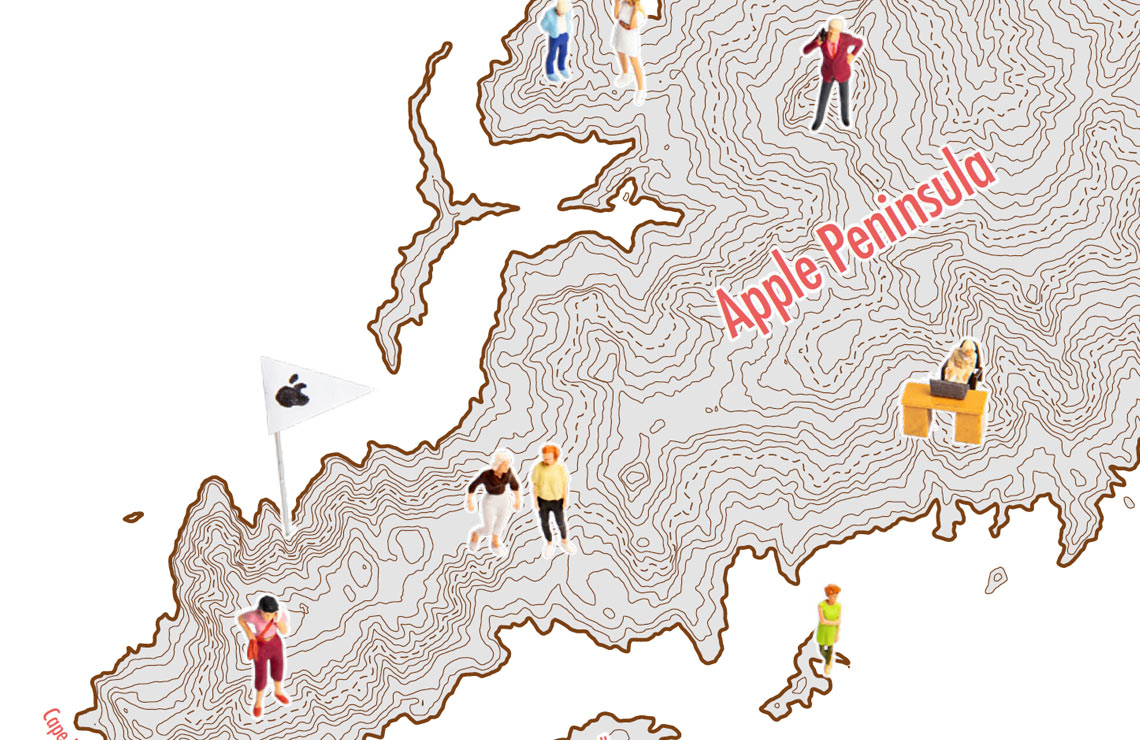
Stuck in the world of big tech
It’s been a rough few years for a handful of US tech companies, due to a seemingly endless stream of scandals and harsh criticism from politicians on both sides of the Atlantic. The result? “Big Tech” is bigger than ever. But what if they have only started to flex their muscles?
Several executives reacted with shock, according to the people in the room. The proposal meant crossing a line, unleashing a hitherto unused weapon. The code name was “Project Amplify”, and it was a new strategy that social media behemoth Facebook hatched in a meeting in early 2021, as reported by the New York Times. The mission: to improve Facebook’s image by using the site’s News Feed-function to promote stories that put the company in a positive light.
The potential impact is enormous. News Feed is Facebook’s most valuable asset. It’s the algorithm that decides what is shown to users when they log in to the site. In essence, it is the “window to the world” for their users, who, totalling nearly three billion, constitute more than a third of all humans on planet Earth.
“Truth” is now the same as “what makes Facebook look good”
For many years Facebook founder Mark Zuckerberg defended the company’s policy on free speech with the mantra that the social network should not be the “arbiter of truth” online, i.e., they would not censor content that people posted. Critics would say that Facebook has been doing this all along, letting its algorithms prioritise what is presented to users. What shows up in the News Feed is what people perceive as important, a form of personal truth for every individual. “Project Amplify” would mean something entirely new. By actively promoting positive news stories about the company, “truth” is now the same as “what makes Facebook look good”.
Silicon Valley veteran and social media-critic Jaron Lanier referred to the major social media networks as “gigantic manipulation machines”, possessing the power to alter emotions and political views among billions of people by pulling digital levers. Now Facebook has decided to use its machine for its own purpose.
We will return to the implications of this, but first, it is important to understand why Facebook and Mark Zuckerberg would want to do this. It is no bold assertion to say that Facebook’s public image is in acute need of a facelift. The company has been plagued by scandals for years. In 2018, it was revealed that the company Cambridge Analytica had harvested data from 87 million Facebook users, data that had been used in Donald Trump’s presidential campaign. The revelation not only tarnished Facebook’s reputation, but it also had real financial consequences. When the story broke in March 2018, Facebook’s stock tanked. In July the same year, Facebook announced that growth had slowed down due to the scandal. The stock fell 20 percent in one day. In a few months, 200 billion USD of the company’s market capitalisation was wiped out.
Facebook’s reaction can be summarised as follows: we are sorry and promise to do better. This has been repeated every time new, negative stories about the company emerge, such as the spread of disinformation, the negative impact Facebook’s product has on the mental health of young people, and how the network was used to instigate genocide in Myanmar, among other things.
If the stock market is a reliable gauge of the future, and it often is, the conclusion is clear: these companies are untouchable
But behind the many apologies it seems Facebook has continued with business as usual. In September 2021, the Wall Street Journal published “The Facebook Files”, a damning investigation showing that the company, including Mark Zuckerberg, was very aware of the harm the platform was causing. The company’s own researchers identified problems in report after report, but the company chose not to fix them, despite public vows to do so.
From the company’s perspective, its strategy has been a success. Advertising revenues have continued to rise and in autumn 2021, Facebook’s stock market value broke one trillion USD, double of what it was before Cambridge Analytica.
The same can be said of the other tech giants. Companies including Google, Amazon and Apple have been at the crosshairs of public debate for years, both for alleged abuse of their dominant market positions and for the negative effect their products and business models can have on people and society.
But if the stock market is a reliable gauge of the future, and it often is, the conclusion is clear: these companies are untouchable. Despite a storm of criticism, court cases and billion-dollar fines, stocks have continued to propel ever upwards. How is this possible? Let’s start with breaking down the different ways Big Tech dominates the world today.
When discussing this topic, parallels are often drawn to the influential corporations of the late 1800s and early 1900s, Standard Oil for example. These comparisons are misleading. Standard Oil and its owner John D. Rockefeller could never dream of the amount of power that rests in the hands of the Silicon Valley-titans of the 2020s.
The new economic superpower
In 2010, the total market cap of Apple, Google, Microsoft, Facebook and Amazon was more than 700 billion USD. That was equivalent to the GDP of the Netherlands. The ascent had been amazingly fast; at this point Amazon was 16 years old, Google twelve and Facebook only six. In autumn 2021, their combined value had reached 9,500 billion USD, more than the GDP for Japan and Germany combined. The total annual revenue for these five corporations is north of one trillion dollars, more than the defence budgets of USA, China, and Russia combined.
The market superpowers
Facebook owns four of the five largest social media networks in the world. Google, owner of the second largest (Youtube), has a 92 percent market share on search. Apple’s and Google’s operating systems, IOS and Android, control 99 percent of the global smart phone market outside of China. Apple takes in 65 percent of the global revenue on mobile apps, and Amazon has 50 percent of the e-commerce market in the US, as well as 32 percent of the global market for cloud services, followed by Microsoft. The list goes on. This not only creates huge profits but also creates an enormous asset in form of the 21st century’s most valuable commodity: data.
The innovation superpowers
Up to 50 percent of the venture capital raised by start-ups circles back to Google and Facebook in the form of advertising, almost as a “tax on innovation”. If new, competing services emerge, Big Tech can either try to buy them or launch competing products. Their headway in terms of resources and user base makes it extremely difficult – if not impossible – to pose a real threat.
The perception superpowers
Twenty years after the 9/11 terrorist attacks, one in 16 Americans believe the US government knew about the attacks and let them happen. Conspiracy theories and disinformation have become the new normal, and research has shown social media plays an important role. What Google and Facebook choose to allow, or not allow, on their platforms shapes our view of the world. In 2012, Facebook conducted an experiment among 700,000 users to see if their states of mind could be altered by changes in News Feed. The answer was yes.
The infrastructure superpowers
In December 2020, Google went down, meaning users could not access Gmail, Google Docs or Youtube. Although the outage only lasted 45 minutes, it made headlines all over the globe. The same thing happened to Facebook in October 2021. As an expert said to CNN: “For many people Facebook is the same as internet”. After the 2008 financial crisis it was clear that a small number of banks were “systemically important”. This is now very true for Big Tech. Serious disruptions in their services would quickly have severe and costly consequences.
The political superpowers
Big Tech has surpassed Big Oil as the biggest spenders on lobbying in Washington D.C., with an increase in spending from 20 to 124 million USD between 2010 and 2020. In the election cycle of 2020, a total of 2.1 billion USD was spent on political ads on Facebook and Google. In a manifest published in 2017, Mark Zuckerberg noted that in elections across the world “the candidate with the largest and most engaged following on Facebook usually wins”. In other words: use us or you lose.
The capital markets superpowers
It could be argued that the stock market has become the most important gauge for global decision-makers. It takes decades to make them do anything to combat climate change, but if stocks drop dramatically, decisive action from politicians and central banks are delivered within days or even hours. This was last seen in early 2020, when fears of the economic impact of the pandemic brought the Dow Jones down by 13 percent in one day. The direction of the stock market is, in turn, more and more intertwined with that of Big Tech. Apple, Google, Facebook, Amazon and Microsoft constitute a quarter of the S&P 500 index.
The AI superpowers
“Dark patterns”. That is what scientists call the tricks that digital companies deploy to manipulate users. Sometimes the purpose can be quite trivial, like making people sign up for a newsletter or share their email. The point is that you as a user do something that you didn’t intend to do. With artificial intelligence these tools become more and more powerful and potentially deceptive. The more data an AI-algorithm can use to train on, the more effective it becomes. This places Big Tech in a unique position to use these techniques. The problem with this is best summed up by Meredith Whittaker, a former Google engineer and now head of the AI Now Institute at New York University: “You never see these companies picking ethics over revenue.”
In all the ways mentioned above, the power of Big Tech is growing bigger every day. It is important to say that not everybody thinks this is a problem. However, it seems like there is a consensus among democratically-elected leaders in both the U.S. and Europe that the influence of these companies must be reined in. The U.S. and the European Union recently agreed to take a more unified approach in regulating big technology firms. In fact, even the people who work in the industry share this view. In a survey of 1,578 tech employees made by Protocol, 78 percent said that Big Tech is too powerful.
So, what can be done? A variety of options are already on the table, from forcing companies to break up to altering laws that give social media companies a free pass compared to traditional media. If the New York Times publishes hate speech they are liable, when Facebook does the same, they are not. In the US, this legislation is referred to as “Section 230”, and there is a debate around whether to change it. At the same time, numerous lawsuits have been filed around the world against the Big Tech-companies on anti-trust issues. The stock market has sent the message that the idea that any of these measures could seriously harm these companies is simply unfounded. And that view could very well be justified. There are several reasons why Big Tech-titans can sleep well at night. Let’s run through some of them.
Breaking up is almost impossible
The businesses of Big Tech are deeply interconnected. It would take years of litigation to make such a decision a reality. With 300 billion dollars of annual profits, the legal coffers of Silicon Valley are limitless.
Fines would have to be astronomical to make a difference
Between 2017 and 2019, the EU slammed Google with a total of eight billion USD in fines. That is less than seven percent of the company’s pre-tax profit during those three years. As the stock market often regards fines as a “one-off”, it is not clear if even larger fines would hurt the market cap at all.
Too drastic of measures could trigger a stock crash
In theory, politicians could of course make new laws that severely hurt Big Tech. This would very likely lead to correction of their stock prices, which in turn would weigh heavily on the start-up ecosystem and the economy at-large. To have voters lose trillions of dollars, or even worse their jobs, is not a price any politician is willing to pay.
The companies could fight back
This is the most underestimated scenario of all. What if Google eliminated negative news stories about Google from searches, or they monitored Gmail and Google Docs to stop whistle-blowers or investigative reporters?
What if Facebook took down the accounts of politicians who are critical of Big Tech? What if Youtube only recommended documentaries that showed how fantastic Silicon Valley is for humanity?
This might all seem rather dystopian, but the question must be asked. After all, anything that can be done with technology tends to be done. With Facebooks “Project Amplify”, this is already inching towards reality. Most importantly, what could anyone do to prevent this? The answer is: nothing.
As things stand now, Facebook and Google are controlled by Mark Zuckerberg and Larry Page/Sergey Brin who own more than 50 percent of the voting power. An American president can be thrown out of office, but no one can sack Mark Zuckerberg. And the reality is that Big Tech can use the power of their platforms for more or less any purpose they please. As Facebook whistle-blower Frances Haugen told CBS 60 minutes:
“The thing I saw at Facebook over and over again was there were conflicts of interest between what was good for the public and what was good for Facebook, and Facebook over and over again chose to optimise for its own interests, like making more money.”
To satisfy Wall Street, Big Tech-giants must deliver constant growth and more profits every year
Here we arrive at the crux of the problem. Silicon Valley’s algorithms govern the world, but these giants are in turn governed by an even more powerful algorithm: the paradigm that is called shareholder value.
To satisfy Wall Street, Big Tech-giants must deliver constant growth and more profits every year. And in the choice between ethics and profit, the answer is, more often than not, profits.
Silicon Valley author and entrepreneur Tim O’Reilly has called Big Tech “slaves under a super-AI that has gone rogue” – meaning the financial markets.
Breaking out of this cycle is easier said than done. Companies like Apple, Google and Facebook use their stock to pay their employees, which means they are highly dependent on stock prices rising.
But bad ethics also runs the risk of alienating these same employees. Internal protests have rocked Google, Amazon, and Microsoft in recent years.
Hurt society or hurt the stock price? Lose staff over scandals or over bad pay? These are the dilemmas that the most powerful companies in history face. Whether Big Tech has really become too-big-to-stop remains to be seen. Ultimately the power rests with you. Without the billions of daily users, Silicon Valley’s influence amounts to exactly zero.
So, if your kids or grandkids one day ask how a few individuals acquired so much wealth and power, the answer is simple: we gave it to them.

Andreas Cervenka
Columnist, Aftonbladet
Years in Schibsted: 10 years at SvD (2007– 2017), at Aftonbladet from December 2021.
Meet our people: Let all people blossom

Meet our people
Julie Schoen’s company DBA has recently joined the Schibsted family, Sanni Moilanen works for our Finish marketplace Tori and Håkan Halvarsson is our new head of People & Culture. Get to know them and what they do.
Let all people blossom
One comment has haunted Håkan Halvarsson more than any other. Growing up, he was often asked: “Why do you always need to go against the flow?” Ever since, it has been clear to him that this is probably the most important thing he can do.
“My mother taught to always question given things.”
Perhaps this thinking will infuse Schibsted – as Håkan’s new assignment is to develop leadership and culture across the company. It’s not exactly a straightforward task in Schibsted, since it consists of many strong and independent brands, each with their own identity and culture.
“The pressure to be a modern and attractive employer has increased enormously. Not least has the pandemic fast forwarded us by 15 years with new ways of working, which is truly creating a global work force. Schibsted’s strength is that we are stronger together.”
In Håkan’s mind the key to fully acting on this advantage is through leadership. And building a common, overarching leadership culture is now high on the agenda. One step on this journey is the recently launched Harvard program in disruptive innovation.
“We also need to build our culture around how to find failures, catapult learning and optimise solutions. Failure is a great force if harnessed well. That’s how innovation happens.”
Going back to that comment about going against the flow, Håkan is also on a personal crusade to promote everyone’s uniqueness as a strength.
“When I think institutions in society, my impression is that they are made to crush uniqueness because it’s simply irritating. If our leaders and our culture could instead view individual uniqueness as a strength and let all people blossom to their full potential, I’m convinced that more success will come to all of us!”
Håkan Halvarsson
SvP People & Culture
Years in Schibsted: 10

Finding unknown treasures
Nice and engaging storytelling is great for inspiration and an effective marketing tool.
Julie Schoen has been working at DBA (Den Blå Avis, the Danish marketplace that recently became part of the Schibsted family) since 2017, and she and the marketing team have taken the idea of telling stories to the next level.
“When I started to contact sellers behind interesting ads, asking them to tell their stories – the effect and the engagement grew, it became a success.”
Today the DBA Guide is now a full site with stories about things for sale, tips on how to “upcycle” used things and guides on how to get your stuff sold. One of the most popular video concepts is about collectors.
“We focus on ordinary things that most people have at home, like puzzles for example. It’s great to show that things you might have in your basement can actually be worth some money.”
For other stories, Julie meets up with people who are selling more unique things, to create entertaining articles and videos, and to show people what they can do with reused things.
“It’s also nice to demonstrate that sellers and buyers are just ordinary people, like you and me. Sometimes people worry about meeting people they don’t know.”
Julie Schoen
Editor DBA Guide, spokesperson DBA
Years in Schibsted: 0.5

Supervisors will build the culture
When Schibsted bought Oikotie, there was a need to create something that could bind the company together with Tori – the other Finnish marketplace owned by Schibsted.
Sanni Moilanen, and the rest of cthe people team in Finland, began looking into a new kind of managerial role, to serve as an enabler for creating a strong united culture, for all 180 employees in the two different companies.
“We needed to build something from scratch that could give us a common foundation”, Sanni explains.
The idea was to define a role that would focus on people, coaching and leadership, instead of functional responsibilities, a concept that Sanni found so interesting that she decided to write her master’s thesis on how to define it – a role they ended up calling “supervisor”.
“The purpose of our supervisor is to empower employees to reach their full potential and to support a more modern way to lead. And we are convinced that this will lead to an innovative culture.”
The role is still new but it has already brought managers together. The onboarding included a “Supervisor Buddy” system in which two managers met and discussed the role regularly. And Sanni is quite happy with the results.
“I believe this is the first step towards our goal of creating a true learning organisation.”
Sanni Moilanen
Learning & Development Manager
Years in Schibsted: Almost 6
I believe it can fly

I believe it can fly
The world’s tech investors are turning their attention to electric planes; but are battery-powered engines enough to get airline companies up and flying again?
But first, let’s get the cultural reference out of the way: R. Kelly believed he could fly, and for a while he did. But he flew too high and ended up a dark hole he won’t be coming out of any time soon. Many of the companies which are currently flying high on promises of electric planes will suffer a similar fate.
Electric aircraft may seem a long way off right now, but things can move fast in the world of technology. No one could envisage a world without air travel, either.
A life-threatening virus and closed national borders knocked the wind out of the airlines. Some of them hit the canvas, while others clung to the ropes and tried to stay on their feet despite feeling groggy and confused. Their revenue streams were cut off, and no matter where you build your levee, water will always find a way. Virtual meetings and advanced presentation tools aren’t actually that new, but the pandemic struck at the same time as these technologies matured. Bit rates have now become good enough, so public and private enterprises – and people generally – were now forced to take a giant leap into a new reality, with communication technology which otherwise would have been lightyears away. They discovered that in most cases they didn’t need to fly at all.
And then came the reports concluding that we should do whatever we could to avoid flying.
Several alarming climate reports from the UN are causing passengers to lose sleep at the mere thought of helping the airlines to stay afloat.
A negligible proportion of the world’s population flies frequently, yet air traffic accounts for around 2.4 percent of carbon dioxide (CO2) emissions. On top of that comes emissions of nitrous oxides, sulphur dioxide, carbon monoxide and soot. An EU report from the end of 2020 confirms that the combined impact of these emissions is at least as serious for the climate as the CO2 emissions alone.
Some airlines are trying to put lipstick on a pig by bragging how fuel-efficient their planes are.
Some airlines are trying to put lipstick on a pig by bragging how fuel-efficient their planes are. And to some extent they’re right; modern passenger planes use way less fuel than they did 20 years ago. But they still use a lot of fuel. And before the virus took off in Wuhan, people travelled way more than they did back then. So, emissions have not dropped over time; they’ve risen dramatically.
Everyone realises that the aviation industry needs to cut its emissions – for moral as well as economic reasons. Many countries have now adopted political strategies to dramatically cut emissions from air traffic in the coming decades. The first airline to offer passengers a climate-friendly, quiet plane – and a good conscience – will laugh all the way to the bank. You only have to look at the auto industry. Part of the reason why investors have money burning a hole in their pockets is that they missed out on Tesla.
A wonderful experience
It just so happens that, at the time of writing, I’m driving a Tesla all over Italy. There are still very few electric vehicles here (and the further south you go, the fewer you see), and the Model S, which is now a common family car in Norway, attracts as much “attenzione” in Italy as a Lamborghini Aventador. Besides, it’s a wonderful experience to move silently through the vineyards with the top down in the low yellow light before darkness falls. And the absence of a cloud of exhaust fumes trailing behind me makes it all the more beautiful.
The future of the auto industry is electric. There’s no doubt about it. Even the present is electric. But somewhere in the mountains in Abruzzo I discovered an uncomfortable truth: the amazing power of an internal combustion engine. There are still some areas where the electric vehicle is outdone: with a petrol-powered car I could have avoided spending endless hours at charging stations; I could have chosen other routes; and I could have driven to out-of-the-way places that lie far beyond the reach of any charging station. I would have avoided having a tiny heart attack from having just about enough battery power to reach a charger but making a wrong turn at a traffic circle and ending up on a freeway heading in the wrong direction.
But things could have been worse. I could have been flying a plane.
Here’s my theory: the further you are from the ground, the greater your range anxiety. If my Tesla runs out of power on a roadside somewhere in Tuscany, theoretically I’ll have time to down a bistecca and glass of a decent Brunello while I wait for roadside assistance. If a plane runs out of power at 20,000 feet, theoretically I’ll have time to say a short prayer before it’s all definitively over.
The apparently insurmountable problem is that the need for more battery capacity increases exponentially with the distance from the ground. Moving a plane carrying cargo and passengers from one place to another demands a colossal amount of energy.
Heavy as lead
In an ideal world, the airlines would simply have replaced the fuel engines in an already approved plane. It would be faster, cheaper and simpler than going all the way back to the drawing board. But it’s not that simple. Electric engines require batteries which (currently) are as heavy as lead. A plane that is approved with an engine weighing, let’s say, one ton with a full fuel tank, would not be able to fly with an electric engine that weighed ten tons with batteries. So, to reduce the weight, you would need to reduce the battery capacity – and consequently the range.
This is what’s giving the industry its biggest headache right now. If enough batteries were crammed into a Boeing 737 to make it possible to fly from London to New York, the plane would be so heavy that it would sink into the runway rather than take off from it. Nor would there be any space for passengers or cargo, which would make the whole exercise pointless anyway.
Big electric passenger planes will therefore not be a reality until the batteries are made considerably smaller and more efficient. We will get there sooner or later, but even the developers says we’re at least a couple of decades away – unless, that is, stopping over 30 times between Stockholm and Rome becomes a viable business model. But this doesn’t mean that electric planes are a bad idea.
Some of these developers may well succeed, but many will be kept afloat by tall tales and naive investors
Loads of companies are now working on developing electric aircraft. Tiny helicopter-like vehicles that can be used as taxis or delivery vehicles are generating the most hype. Many of them look ultra-cool, resembling the futuristic drawings we did in elementary school in the 1980s, with people wearing silver clothes, eating pills instead of food and whizzing around with jet packs and flying cars.
Some of these developers may well succeed, but many will be kept afloat by tall tales and naive investors. Many have already failed, and more will follow. The most exciting and promising developments are happening in the more conventional part of the aviation industry. Only once passenger planes become electric will they really take off.
Two trends stand out
SAS is collaborating with Airbus, United with Swedish startup Heart, and Easyjet with the American startup Wright Electric, and so on. Most of the airlines are desperate to get an electric plane into the air because it could prove profitable – and sooner than you might expect.
If you compare today’s aviation industry with that of the 1980s, two trends stand out:
- The regional airports are increasingly underused.
- The airlines are flying bigger planes with more seats.
These trends are driven by the fact that the cost of buying and maintaining an aircraft engine is roughly the same regardless of size and trip distance. This makes small passenger aircraft for short routes less profitable. In the 1980s, the average number of seats on regional flights was 20, whereas today it’s 80.
This does not necessarily favour the interests of passengers; they have to spend more time and money on reaching the large airports, they depart from somewhere far from home and land somewhere far from their final destination, and do so in huge, noisy and polluting planes.
Regional flight might be profitable
Investors and founders of companies like Heart and Eviation in Israel claim that the cost of buying and maintaining an electric engine is a fraction of the same cost for a fuel engine, and that electrification can therefore make regional flights using small aircraft profitable again.
In September Rolls-Royce completed a successful 15-minute flight test in “Spirit of Innovation”, an all-electric aircraft in the south of England. The aircraft only has one seat, but the experience gained will be used to develop a passenger aircraft.
Tecnam in Italy is hoping to have an all-electric aircraft with a capacity for nine passengers in the air in 2026, complete with a Rolls-Royce engine. Norway’s Widerøe has shown an interest, since a large proportion of its flights cover short distances in northern Norway. The range at the time of launch will be around 200 kilometres. Heart Aerospace, which is based outside Gothenburg in Sweden, is working on an electric plane for 19 passengers. The range at the time of launch will be 400 kilometres.
Sceptics would dismiss these performance properties as ridiculous compared to fuel aircraft, in terms of both passenger capacity and range. But here’s the interesting part: 400 kilometres is enough to cover around 80 percent of the routes in markets like those in the Scandinavian countries. Other interesting markets for this type of aircraft include island-hopping in countries like Indonesia, Greece, Japan and the Philippines, or indeed any country with mountain ranges or lakes that take a long time to traverse. Or for moving troops and crews. Air ambulance services. You name it.
This summer, the American airline company United placed an order for 100 of these aircraft with Heart.
Severe economic impact
It’s happening now … or soon will be, at least.
As we know, the aviation industry was hit hard by the coronavirus pandemic in 2020. Few people wanted to travel, and those who did were not allowed. The airlines’ revenue streams dried up, and orders for new aircraft and engines were cancelled.
The economic impacts were severe. Rolls-Royce lost 4.5 billion USD in 2020, and had to cut around 7,000 jobs to save money as well as make some tough priorities in other parts of its operations. This will likely delay deliveries of new engines by several years, which in turn may create delays for Tecnam and Widerøe. So the chances of sitting in an electric plane any time soon are slim, though it may well be a reality by 2030.
In the meantime, see you on Teams.

Joacim Lund
Technology commentator, Aftenposten
Years in Schibsted: 16
Uncertainty is like driving on an ice patch

Amy Webb and her Future Today Institute team has helped Schibsted isolate six trends that the company needs to lean into. Photo: Emil Wesolowski
“Uncertainty is like driving on an ice patch”
How do you face the uncertainties of the future without a crystal ball? You analyse data and you prepare as best as you can. In the Horizon project, Schibsted is doing just this together with the Future Today Institute and its founder Amy Webb.
The Horizon corporate strategy project was created with the purpose of creating a common understanding of mega-trends shaping Schibsted future in five to ten years and rehearsing multiple futures through plausible scenarios. The project was created by Schibsted together with Tinius Trust/Blommenholm Industrier and the Future Today Institute, to make Schibsted better equipped to succeed – regardless of how the future develops.
Futurist Amy Webb and her team at Future Today Institute have worked closely with Schibsted’s Anders Grimstad and Zuzanna Zyglado-Stenberg to create a plan for whatever the future may hold.
Webb explains this work as looking for signal data early, thinking about what that might mean and starting to model alternative futures that describe next-order actions.
Slowing down the process of change
“There’s an analogy that I like to use to describe what this process is like. I’m originally from Chicago in the United States, where there is a ton of snow, lots of ice, lots of wind – it gets very, very cold”, Webb says, something her hometown has in common with the Nordics.
In both places, anyone with a drivers license needs to learn to drive on ice. She says this moment that we’re living through, with uncertainties in business, regulations, environment and regarding the pandemic, is very much like being in a car sliding around on ice.
“When you’re driving, and you’re hitting an icy patch, at that point, your limbic system starts to take over. You get really nervous and you start a lot of super-fast, haphazard decisions.”
She explains that your brain believes that if you slam your foot on the break right then, the car will stop. But that’s not the case. Slamming your foot on the break will just cause greater problems. So what do you do instead?
“You’re supposed to steer your car into the direction that you’re sliding. That feels wrong in the moment, but as you know, if you keep your eyes on the road further ahead, what steering into the slide does is it slows down the process of change.”
That’s what we should be doing right now, in business as well, even though it feels wrong, she says. We should be leaning into uncertainty.
“I think it’s all about recognising those uncertainties but also exploring the white space. Where are all the possibilities for Schibsted to grow in ways that you just haven’t thought of before?”
Created clusters of trends
Starting this project, the Schibsted team, together with FTI, created baseline futures based on interviews with the top stakeholders and leaders. Ironing out where they agree and where they disagree on what the world will look like in five to ten years allows them to see where our uncertainties lie. From there, FTI was able to look into their data to see which trends coincide with Schibsted’s interests (look into the six overarching trends here).
With trend clusters in place, FTI is now ready to create future scenarios, being the next milestone in the Horizon project. A key thing to bear in mind when looking into the future, though, is that it’s not as far away as you might think. Preparing for tomorrow means acting now, creating a plan for next year with a ten-year perspective, or even six months ahead, but always with a long-term perspective in mind..
“There’s already a case where Schibsted saw the challenges of the future and acted in time to change and grow”, says project co-lead Zuzanna Zygadlo-Stenberg, referring to establishing online classified at the beginning of 2000s with Finn.no. At the time, Schibsted was a media company faced with the uncertainty of what what the future promise of the internet might hold.
“We managed to adapt, build marketplaces and take a position in a new space and become profitable. Understanding the great forces, how to use them to our advantage and create growth”, Zygadlo-Stenberg concludes.

Camilla Buch
Advisor Editorial Content
Years in Schibsted: 1.5
Enter the Metaverse

Enter the Metaverse
Facebook is hiring 10,000 people to work on it. The Metaverse is no longer science fiction – some say it’s the next Internet.
Throughout the last few decades, much of what we previously considered science fiction has become more science than fiction. We may not have flying cars yet but asking your fridge to create a grocery list is an everyday occurrence. And – as has been stated so many times before – our precious smartphones have more processing power than NASA did when it sent Neil Armstrong and Buzz Aldrin to the moon. So it shouldn’t come as a surprise to us when terms like “the metaverse” are no longer constrained to The Matrix and Ready Player One. But before we look at how the metaverse will impact our future, let’s understand it.
A futuristic virtual world
The term “metaverse” was coined by author Neal Stephenson in his 1992 novel “Snow Crash”. He used the term to refer to a 3D virtual world inhabited by avatars of real people. The term comes from “meta” (beyond) and “verse” (from universe), and it is typically used to describe a futuristic virtual world on the internet in some form. Still, the term, as it pertains to an actual, real-world phenomenon, doesn’t really have a universally accepted definition.
Venture capitalist and author of “The Metaverse Primer”, Matthew Ball, writes that “The Metaverse is best understood as ‘a quasi-successor state to the mobile internet’”. This is to say, it’s a technology that will completely change how we operate in the world but also take a long time to develop based on many different, secondary innovations and inventions.
Since metaverse is not a completely developed term with a clear definition, it’s tricky to pin down, but I’ll give it my best shot. Currently, as far as we can define it, the metaverse looks like a successor to the internet in which its users are more tangibly connected to the virtual experiences taking place there. That could be via everything from voice interfaces, to VR headsets and haptic wearables.
We’re already unlocking our phones via facial recognition and buying digital art via non-fungible tokens.
In the long run, it is believed that all of these experiences will be connected and collected in the metaverse, just like the internet is the collection of a vast universe of 2D websites. The Verge has broken down the parts of the metaverse that most excite the tech industry right now, things like “real-time 3D computer graphics and personalised avatars,” and “a variety of person-to-person social interactions that are less competitive and goal-oriented than stereotypical games.”
Previously mentioned author Matthew Ball believes that the metaverse will have as big of an impact on our daily lives as the electricity revolution and the mobile internet. It’s also an interaction of the same kind – the internet (and its iterative version, the mobile internet) couldn’t have happened without the electricity revolution, and the metaverse couldn’t happen without the internet.
Ball writes that the “metaverse iterates further by placing everyone inside an ‘embodied’, or ‘virtual’ or ‘3D’ version of the internet and on a nearly unending basis. In other words, we will constantly be ‘within’ the internet, rather than have access to it, and within the billions of interconnected computers around us, rather than occasionally reach for them, and alongside all other users and real-time”. Facebook CEO Mark Zuckerberg, who is a big proponent of the metaverse, has described it as “an embodied internet”.
10,000 new workers
His plan is to shift Facebook from a social media company to a metaverse company, and he’s already put this plan in motion. The company will change its name – the social network will keep Facebook but the parent company will be renamed, much like Google’s approach with its parent company Alphabet. This could be to avoid the less than stellar reputation linked to Facebook, but it also symbolises the shift in course. Zuckerberg plans to employ 10,000 new workers in Europe to join the company’s components and create this metaverse.
Now, that all sounds very sci-fi. But it’s really just the next step in the development of things we already take for granted. We’re already unlocking our phones via facial recognition and buying digital art via non-fungible tokens. Admittedly, it feels more far more far-fetched that we’ll be having our team meetings remotely via VR setups, sitting on our couches at home while appearing at a conference table in a virtual space with our colleagues.
Independent tech analyst Benedict Evans explained the current discourse around the metaverse like “standing in front of a whiteboard in the early 1990s and writing words like interactive TV, hypertext, broadband, AOL, multimedia, and maybe video and games, and then drawing a box around them all and labelling the box ‘information superhighway’”. Essentially, we’re merging tech and concepts such as augmented reality, virtual reality, mixed reality, gaming, cryptocurrencies, non-fungible tokens and more, under one umbrella.
Connectivity is the key difference
I’ve started thinking about the theory of the metaverse like electricity. The idea is that we’ll be using it so naturally in our daily lives, when swapping our glasses for AR glasses with interactive screen overlays, that we don’t even think about it unless it goes down. As I mentioned before, we already use an extended internet, in which our physical bodies, voices and gestures are connected to our devices (think face scans, voice assistants, and VR). The metaverse is the extension of this. Perhaps we’ll all have virtual avatars representing ourselves online, for which we buy virtual designer clothes and virtual bespoke art pieces with non-fungible tokens.
The key difference between that and what we have today is connectivity – between ourselves and the virtual world, and between the many different existing virtual worlds. Especially following the giant disruptor that is the Covid-19 pandemic, the need to physically engage with other people is huge, but so is the need to connect with people over vast distances in just a matter of seconds. The metaverse could be a merging of the two needs.
The major challenge with this, of course, is that not everyone has access to the tech fuelling this development – a lot of people don’t even have access to a reliable internet connection. Just as the smartphone accelerated the mobile internet, other personal devices will be the driving forces of the hypothetical metaverse. The smartphone is relatively accessible for the majority of people today, but that wasn’t the case when ideas about a mobile internet arose. Just like all other technical developments throughout history, the metaverse will surely develop into something completely different than how we first imagine it now. But until then, I’ll look forward to meeting your avatar form in my virtual palace filled with non-tangible art in the near future.

Camilla Buch
Advisor Editorial Content
Years in Schibsted: 1.5
We will only invest in companies aligned with our values

“We will only invest in companies aligned with our values”
He has billions of NOK to spend to help Schibsted grow even more. Andrew Kvålseth is the new Chief Investment Officer, hired to build on the success of Schibsted’s prior successful investments.
Schibsted is a growth company, it has already reinvented itself so many times through investments, and that’s what we need to continue to do to be successful over the long-term.”
Andrew only just began in August 2021 and his role is new. But Schibsted’s has a strong history of making successful investments. From printing, to news, to digital media. And not least, Schibsted brought classified ads online and made a series of international marketplace investments, which eventually became Adevinta, a company worth more than 150 billion NOK.
Now, some of the capital from these successful investments needs to be redeployed to create a strong portfolio to diversify and drive the future growth of Schibsted and – not least – to support its underlying mission of empowering people in their daily lives. Andrew will work with Schibsted Ventures, and all other investment teams across the company, to support this mission.
News media a core part
“There are many attractive opportunities for a company like Schibsted. In my view, news media is a core part of our purpose, especially considering what is happening around the world – trustworthy news are more important than ever. Schibsted’s DNA is news and we have done better than mostAs an example, he mentions the NYT who is very proud of its seven million paying subscribers, and has the whole English-speaking world as its market. Compared to this, Schibsted is doing very well with more than one million subscribers.
“Still, there is so much potential. You can either look at the media industry as something fixed – or be part of innovating it. We choose the latter.”
News might be core – but from an investor’s point of view, marketplaces is a much broader arena and the other areas where Schibsted operates today is of course also on the agenda: like financial services, e-commerce and distribution. In all these areas, Schibsted has experience and know how to grow and scale.
But whatever area Andrew and his team will look into, Schibsted vision and mission are key.
“It’s our guard rail and boundary. We will only invest in companies that are aligned with our values.”
In Schibsted, there is always this question of which language to speak when you meet people. We have quite a few people from different countries in the organisation and their names don’t always help. Kvålseth is very Norwegian – and yes, Andrew was born in Trondheim. But the family left for the US when he was only one year old. He has been back to Scandinavia on several other jobs in the past, and he’s been working in the US, Asia and the Middle East. He has, of course, had a good knowledge of Schibsted through his line of work – but also through some of our services.
“I use Finn a lot – and I actually read Aftenposten daily to learn more Norwegian, and stay informed.”
A complex company
Now he and his Norwegian wife have ended up back in Norway, after many years in Asia and the Middle East. While they enjoyed the time abroad, they started to think about where they wanted their children to grow up and have a more permanent “home”.
“We were in a position where we looked at the globe and asked ourselves where we wanted to live. Choosing the Nordics was a conscious decision – with its values, equality, open society and healthy lifestyle.”
So, many things with joining Schibsted were a match – even though he has learnt that Schibsted with all its different brands and divisions is a much more complex company than he first believed.
“From the outside, I was always impressed with Schibsted and the incredible success they have had at innovating, investing and reinvesting themselves. But it’s like I ate this awesome sausage, and then I saw how it’s made – it’s really complicated with so many brands and businesses. But that is also part of what makes it work so well.”

Ann Axelsson
Senior Product Manager, Strategic Communications
Years in Schibsted: 23
A superposition to change computing

The quantum computers that exist today typically look like large chandeliers, hanging from the roofs of science labs.
A superposition to change computing
Is quantum computing the next major revolution in computer science or will it remain a dream scenario for the foreseeable future? Sven Størmer Thaulow, EVP Chief Data and Technology Officer, looks into an area that is still surrounded by myths.
The fields of quantum mechanics and quantum computing are difficult to understand, even for people who have studied them at university level. But what are they, and what makes their application in computer science so interesting?
First we need to take a step back. Data processing traditionally operates via a digital computer language; everything – images, sounds, text, etc – is broken down into 1s and 0s. When I write “S” using my keyboard, it represented as “01010011” – the ASCII character code in binary format. This is done by feeding current into eight “transistors” in a processor (or chip), with different voltage levels representing the binary states of “1” or “0”. A thing inside the computer reads this and displays “S” on my screen.
Packing transistors
In data processing, building more powerful computers has largely been a matter of packing as many transistors as possible into a chip and getting the clock frequency (the speed at which the computer computes) as high as possible. Many will be familiar with Moore’s Law describing the increase in processing power. It states that the number of transistors on a chip will double every other year. It’s hotly debated, but for some years now, many have claimed that Moore’s Law will soon be dead and that we have reached the limit for how many transistors can be packed into a chip. We’re currently down to three nanometres between the transistors, with the standard distance on your Iphone chip being five nanometres. Attempts to remedy this are being made by designing processors in 3D and other techniques.
However, increased computing power is not just about the number of transistors on a single chip; today we buy vast amounts of computing power in the cloud and no longer have to rely on having our own computers in-house. This means that we can all easily access vast resources to solve computing problems precisely when needed, no more, no less.
Machine learning behind the demand
Demand for such computing power has grown especially rapidly due to the need to train machine learning algorithms on large datasets. These algorithms try to find an optimum in a system with a large number of dimensions (for example, housing prices) – a big mathematical problem. Just imagine how many variables that influence the price of a house. The bigger and more complex the optimisation task, the greater the need for computing capacity – a need it will be difficult to keep up with using conventional data processing techniques. Even today, tasks already exist that are so complex that running them on even the world’s biggest computer cluster is inconceivable. This is where quantum computing is emerging as a promising technology.
Quantum computing is about using quantum mechanics – the theory of how things interact at small scale – to create a computer that is insanely faster at solving certain problems than a conventional binary computer. A quantum computer does not have bits (no 0s or 1s) but rather qubits, i.e. bits with more states than just 0 or 1. Qubits draw on two properties that distinguish them from regular bits: first, they can be put into a “superposition state” that represents both 1 and 0 simultaneously. Second, multiple qubits can be entangled, meaning that states in pairs of quibits can be changed immediately.
Another important difference be tween quantum computers and con ventional processors is how computing power is scaled. To double the computing power in a conventional processor, you essentially need to double the number of transistors. In a quantum computer, the computing power is doubled with every additional qubit. This means that the computing power in a quantum computer grows exponentially when the processor is scaled.
Combined, this enables quantum computers to perform multiple computing operations simultaneously, churning their way through computations which today’s biggest supercomputers would take thousands of years to complete.
This sounds incredible, but at what stage are we at in the development of quantum computing?
More than 40 years old
Well, the theory of quantum computing is more than 40 years old; in 1981 the American physicist and Nobel laureate Richard Feynman said: “Nature isn’t classical, dammit, and if you want to make a simulation of nature, you’d better make it quantum mechanical, and by golly it’s a wonderful problem, because it doesn’t look so easy”.
In many ways it can look as if we’ve reached the same point in solving that problem as the internet had in the early 1990s. Most work is currently being run in labs, though industry is beginning to grasp its potential. Big Tech companies (such as Google and IBM) have launched separate research programmes. Venture capital firms are investing in quantum startups. The first exclusively quantum companies have gone public. National authorities are investing strategically in the defence sector, among others, after having financed basic research over several decades.
Yet we’re still lagging behind when it comes to application. We’ve not yet reached the point of “quantum advantage”, at which a quantum computer can solve a problem faster than a computer using conventional data processing. Researchers expect the first case of quantum advantage will be achieved some time in the next three to five years.
The aim of quantum computers is to perform computations that no conventional computers can realistically manage. A major task that lies ahead will be to explore their applications. And to do this we need to think differently. New computational strategies must be developed to take full advantage of these totally new devices. The mathematics and the algorithms underlying the tasks to be performed will be fundamentally different.
Easy to miss the mark
Researchers and innovators often miss the mark when getting to grips with new innovations: Thomas Edison thought that the phonograph he invented would be used primarily for language learning; the developers behind text messaging thought it would primarily be used by courier companies to notify their customers of parcel deliveries. So what do we think quantum computers will be used for? Three likely areas stand out:
- Large-scale optimisation problems where the task is to maximise an output based on an inconceivably vast number of variables simultaneously. Some practical examples of application are in the transport sector, for finding optimal routes, or in finance for optimising profit based on a seemingly endless list of constraints and variables.
- Classification tasks using machine learning. A typical example of a classification task involves putting labels on images, for example: “dog”, “tree” and “street”. Quantum computing has proven to be more efficient at performing complex classification tasks.
- Simulation of nature, such as in molecular modelling. Modelling anything other than the most basic chemical reactions is mathematically impossible for conventional computers, but with a quantum computer this may be doable. Development of medicines and batteries are two practical examples of potential areas of application.
A supplement
The key point here is that when or if quantum computers become commercially available, they will serve as a supplement to conventional data processing. State authorities, hyperscalers (Big Tech companies) and large universities are expected to be the early adopters of quantum computers due to the fact that they will probably need to operate at extremely low temperatures in dedicated facilities. So the number of quantum computers will likely be small initially – that is, given today’s technological constraints.
That said, quantum computers will more extensively be offered as a cloud-based service, on par with conventional data resources, and be made available using much simpler user interfaces (high-level programming language) than those we have today, where developers in reality need to understand quantum mechanics in order to program the machines.
So what does this mean for Schibsted? We will monitor developments, but will probably wait a few years before we start experimenting with the technology – and when that day comes, we will do it using cloud-based quantum computing.

Sven Størmer Thaulow
EVP Chief Data and Technology Officer
Years in Schibsted: 2.5
Waging the war for talent

Waging the war for talent
Global talent shortage is on the top agenda for all organisations. In Schibsted, new ideas on how to address this are up for discussion. Offering partly remote work to employees is one key effort. We also look into some more key people trends.
Talent shortages are at record highs and unemployment at multi-decade lows. According to Gartner’s Emerging Risks Survey 2021, global talent shortage is now the top emerging risk for all organisations. Technology driven organisations also anticipate skill gaps in key roles post-pandemic, while dealing with one of the highest global attrition rates, at 13.2 percent annually.
Research also shows that 46 percent of the global workforce is potentially planning to change jobs as they now can work remotely. Remote job postings on Linkedin have increased five times since the pandemic outbreak. We are entering a talent migration that is larger than anything we have seen before, where many people are rethinking not just how we work, but why we work. More people will be doing work they love at companies they feel passionate about, leading to greater success for organisations which engage their employees with empathy, trust and purpose.
To tackle what is to come, employers need to step up their game to continuously develop and reskill their workforce and rethink how they can attract and recruit talent.
At Schibsted, we recognise these challenges, but also the opportunity to support and enable the building of new workplace norms that lead to both greater employee fulfilment and better business results.
Investing in a talent agenda with new solutions for hybrid work, personal development and employee experience will be crucial to succeed in the unprecedented war for talent that we are up against.
These are some of our ideas to meet the challenges:
Trusted leadership
We know from research that companies with superior leadership outperform other companies on the entire talent agenda. As role models, our leaders are key drivers of culture as well as the strategic agenda. We believe that continuous leadership training and programs to build on our principles and group strategy will be as important as ever.
Diversity, Inclusion and Belonging
In September 2021 Schibsted hired its first Global Head of Diversity, Inclusion and Belonging (read the interview with Sumeet Singh Patpatia on pages 54–55). This is the first step to establish a group-wide approach to the question on how Schibsted can create competitive advantage through an inclusive culture.
Inspire people to grow
Research confirms that the main reason employees leave an organisation and the primary reason they join are career opportunities. At the same time, 75 percent of organisations are anticipating skills gaps in key roles. In Schibsted we have taken the first steps in building a “learning organisation”. We believe our ability to learn and translate the learning into action rapidly, is an ultimate competitive advantage. Our
Learning organisation strategy includes:
- Dedicated time for development (ten percent within tech)
- Sharing learning processes and practices through common learning platforms
- Strategic plans for competence development for all employees
- Increasing the level of cross-Schibsted employee mobility
- From industry to graduate hire at scale
We strongly believe that hiring for learnability will be the sustainable approach for the future. Acquiring learnability and providing unproven talent with great learning opportunities and career paths are keys to success to attract and retain talent.
Read more: People trends in short

Mette Krogsrud
EVP people & Corporate Affairs
Years in Schibsted: 8.5
Why groupthink is bad for business

Sumeet Singh Patpatia has been interested in diversity issues for a long time. For twelve years, he’s been organising Turban Day in Oslo. Its goal is to make Norway the best country in the world to be different in.
Why groupthink is bad for business
His aim is to make his newly created role obsolete, and to make Schibsted the world’s best workplace when it comes to being different. Sumeet Singh Patpatia is Schibsted’s Head of Diversity, Inclusion and Belonging.
“When I grew up, I was one of only three kids with dark skin in the whole of my preschool. I was always different, and I lived in two different worlds: the Norwegian one outside my home and the one inside my family, and I had to learn how to navigate both.”
It’s this experience that led Sumeet Singh Patpatia to his role as Head of Diversity, Inclusion and Belonging in Schibsted. By living in those two separate worlds, he learned early on that there were advantages to understanding other groups, though up to now his interest in overcoming differences had been something he did in his own time. In his professional life he worked on digital transformation and business development.
“I didn’t know you could do it as a job! I’ve been interested in these issues since I was a teenager, but only in my spare time.”
Crucial for the business
The reason why he can now bring this interest into his professional life is the growing insight in Schibsted that we need to act proactively to achieve a more diverse workforce – and that we’ll lose our competitive edge if we don’t. It’s crucial for attracting the best talents, for developing products and for innovation.
“Many companies have a challenge in reflecting the population. If we always recruit people who are like ourselves, we’ll have a problem; we’ll miss out on a lot of the talent out there”, says Sumeet, who also stresses the importance of drawing on different perspectives in product development.
“If you want to innovate and enter new markets, you need to hear multiple perspectives. Groupthink can be bad for business.”
But he also thinks it’s easy to lose sight of diversity from the traditional perspective when what really matters is inclusion, and that many people today feel excluded even though outwardly they seem to belong to the group of people they work with.
“Being excluded hurts. Some research show that social and physical pain has the same effect on our brains.”
Raising awareness and providing tools
In practical terms, Sumeet’s role is to ensure that Schibsted has diversity competency and diversity maturity, and that these are connected to inclusion and belonging. In the first phase he will analyse what that looks like by talking to many people throughout the organisation. The next step is to devise a plan which he already knows will include training for managers.
“It’s about raising awareness, but also about providing managers with tangible tools. As a manager, how comfortable are you meeting someone who is blind, has a different sexual orientation from you or who wears a turban? Do you dare to be curious and try to understand what it means? That’s where my role comes in.”
Hi also thinks that in Schibsted today there is a lot of diversity which isn’t utilized to the fullest.
“Potentially there is a lot of value in giving this diversity a voice. Thus, it is not just about recruiting diversity, but more importantly including diversity. Including all.”
As a Sikh, Sumeet wears a turban. It also plays a role in the project he’s most proud of. For twelve years now he’s been one of the organisers of the Norwegian Turban Day in Oslo, an international event staged in April every year to raise awareness of Sikhs and of the turban as part of their culture and religion. The Oslo event’s goal is to make Norway the world’s best country to be different in and the general public is invited to wear a turban for a day. Sumeet refers to it as a roundabout way of “mimicking” another culture, but he thinks it has a lot of value for understanding others. And he now sees that the Turban Day project succeeded in that; in a recent survey on the level of acceptance of various symbols in Norway, the turban ranked a joint third with the Christian cross.
Now he’s committed to making the Schibsted project the one he’ll be most proud of: “We’re going to make sure that you and I and everyone can bring our whole selves to the workplace.”

Ann Axelsson
Senior Product Manager, Strategic Communications
Years in Schibsted: 23
A polish hub changed the way we work
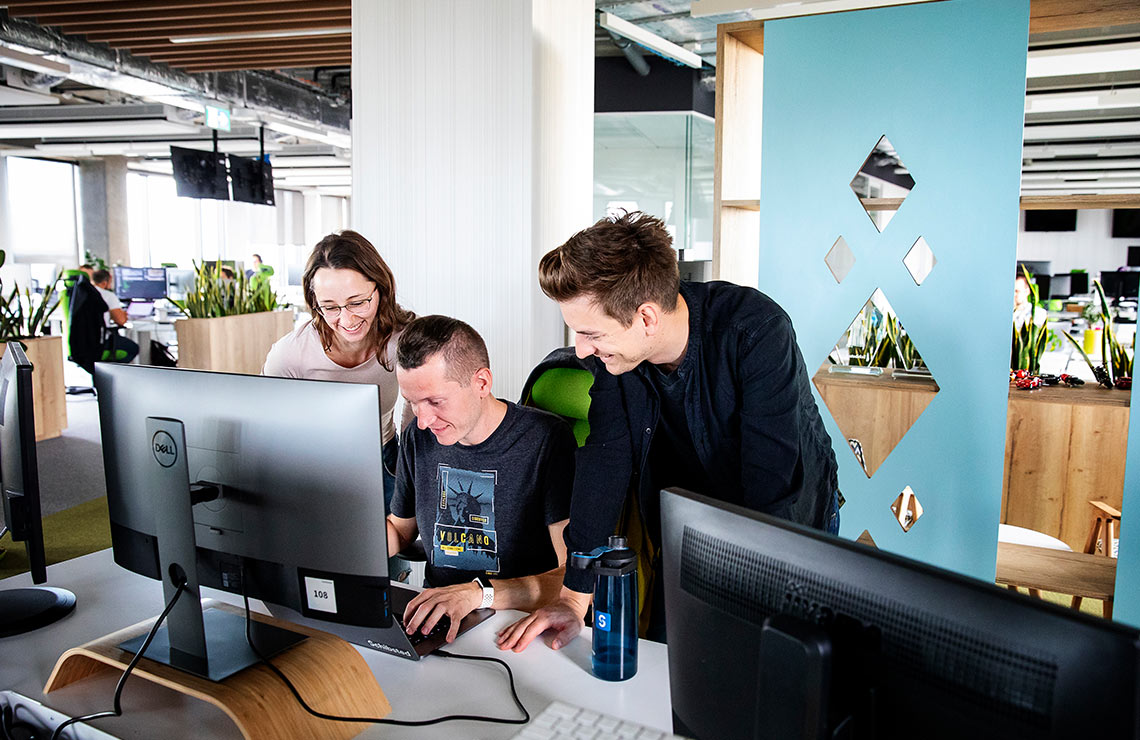
A polish hub changed the way we work
The pandemic changed our way of working. But for many Schibsted companies, the road to a distributed work style started in Krakow ten years ago when the tech hub in Poland was established.
It was a biting cold January day in 2012. A group of Polish and Norwegian product and tech people were gathered in a conference room in Andels Hotel in central Krakow, Poland. The atmosphere was tense as the group tried to get to know each other. Only one topic was on the agenda: how do we work together as one team that’s located in both Krakow and Oslo?
Little did we know then that ten years later Schibsted Tech Polska would grow to more than 250 employees and become an indispensable part of Schibsted’s product and tech organisation.
But this is also a story about how teams from different Schibsted brands started working together for the first time – and how the first distributed development teams were created.
Back in 2011, working from different locations was unimaginable for most teams in Schibsted. Practically all software engineers were based in the same locations as the brands they supported. Video meetings were equally rare. But with the Poland hub, an early form of hybrid work emerged, where all teams were distributed.
Collaborating across cultures
Almost no teams operating out of the Poland hub have all their people in Poland alone, which is why video conferences and digital collaboration tools have been key to collaboration since the beginning. Another important aspect has been collaboration across cultures and brands – and building a hub that attracts tech talents.
“In Schibsted, the tech hub in Poland is unique because it is a pure tech company. Basically, all the employees are software engineers. This, together with the Scandinavian work culture, is how we can attract the best talents,” says Konrad Pietrzkiewicz, who joined in 2012, and is today part of the Schibsted Tech Polska management team.
Schibsted Tech Polska grew out of Media Norway Digital, a joint product development unit for Schibsted’s subscription-based newspapers in Norway.
In 2011, the urgency of planning for a digital transition was weighing heavily on the top management in the media houses. This led to a flow of ambitious digital product plans.
With some 20 employees at the time, Media Norway Digital struggled to respond quickly enough. Many more developers were needed. But they were almost impossible to recruit in Norway.
A radical decision was made: We would have to look abroad for our next colleagues.
Several cities were considered. In the end, Krakow was chosen because of its proximity to Scandinavia and the many technical universities producing a steady flow of young software engineers.
The new company was established at record speed in the autumn of 2011. Within a few months offices had been rented, furniture from Ikea assembled, and the first two teams recruited. Video conferencing equipment was shipped from Norway and the new colleagues met for the first time.
The even bigger nut to crack was how to develop mutual trust between the new Norwegian and Polish colleagues. Many were sceptical at first, especially since many other companies had failed in setting up this kind of distributed team structure.
Starting with the meeting in Andels Hotel, ground rules were set to establish the right culture:
- We would always talk about being one team – across countries. Always say “us”, never “they” and “we”.
- The standard of offices, laptops, video conferencing systems and other equipment would be at least as high in Krakow as in Oslo, if not higher.
The teams were encouraged to meet physically and often to get to know each other on a personal level, and to make sure that everyone had the same understanding of the problems to solve. - All teams had to meet every day on video. This rule was relaxed later, but in the beginning it was crucial to put in place a culture of frequent communication.
The first offices only had space for 30 people. But in only a few weeks, VG and Aftonbladet asked if they could also set up teams in Krakow. Already by May 2012, the company had completely revised its strategy. A new and bigger office space was leased. It would now be a tech hub welcoming all Schibsted brands.
But to join the brands had to promise to collaborate. There should be open and free knowledge sharing across the brand teams, and all code produced in Krakow could be freely reused by other Schibsted companies that also had teams in Poland.
The new offices soon looked like a United Nations of Schibsted, with brand logos filling up the walls: VG, Aftonbladet, Aftenposten, Stavanger Aftenblad, Bergens Tidende, Finn, Distribution Innovation and more.
Almost every month new brands joined, and within a year there were close to 100 employees.
Like a cool small start-up
“We had been told several thousand people worked for Schibsted. But the reality is that we felt like we all worked in a cool and small start-up. It was fast-paced, informal and everyone knew each other,” Konrad reflects.
He was recruited as team leader for VG in Krakow in May 2012. VG had decided to give one of its most important projects to the Krakow team. The project was to build a new web-TV platform.
“I had worked for a Polish media company before. This was my chance to step up the game with an international media group,” Konrad explains.
Konrad and his team embraced the VG culture immediately. And as with the other teams, they were eager to prove they could be trusted with the projects they had been given.
“I would say it was a healthy competition between the brands. In many ways we inherited the culture from the newspapers in Scandinavia, and we were all eager to demonstrate that our team was the most innovative,” he says.
Konrad’s team was also the first to develop a product that would be scaled and used by other media houses. Today all Schibsted’s news brands use the streaming platform developed in Krakow.
“I am really proud of that. And it was exciting. We really had to push our limits to make it happen.”
Informal atmosphere
Over time the new colleagues learned to work well together, despite cultural differences. Many Polish developers came from companies with a more hierarchical structure than in the laidback Scandinavian work culture. They were surprised about the informal atmosphere, and especially the friendly tone between managers and employees. On the other hand, Scandinavians were taken aback about the ambitious dedication and high competence level of their new colleagues.
In 2014, a second office was opened in Gdansk.
This site became a base for teams working with Schibsted’s brands within ventures and financial services. Today more than 250 people work for Schibsted Tech Polska.
Konrad Pietrzkiewicz is now part of the management team. He is still responsible for Schibsted’s streaming solutions, and his team is one of the most long-standing development teams in Schibsted.
He has stayed on for almost ten years for two reasons.
“First I strongly believe in video in media – and love taking part in developing the best solutions. But equally important: I am passionate about integrity in the news. In Schibsted I can combine these two.”
Schibsted tech polska
- Established in October 2011 as a development unit in Krakow, Poland working with Media Norway Digital.
- In the spring of 2012 it was changed to a tech hub welcoming teams from all Schibsted brands.
- Today Schibsted Tech Polska has around 250 employees in Krakow and Gdansk.
- Currently has software engineering teams working for all business areas in Schibsted as well as the central Data & Tech unit.
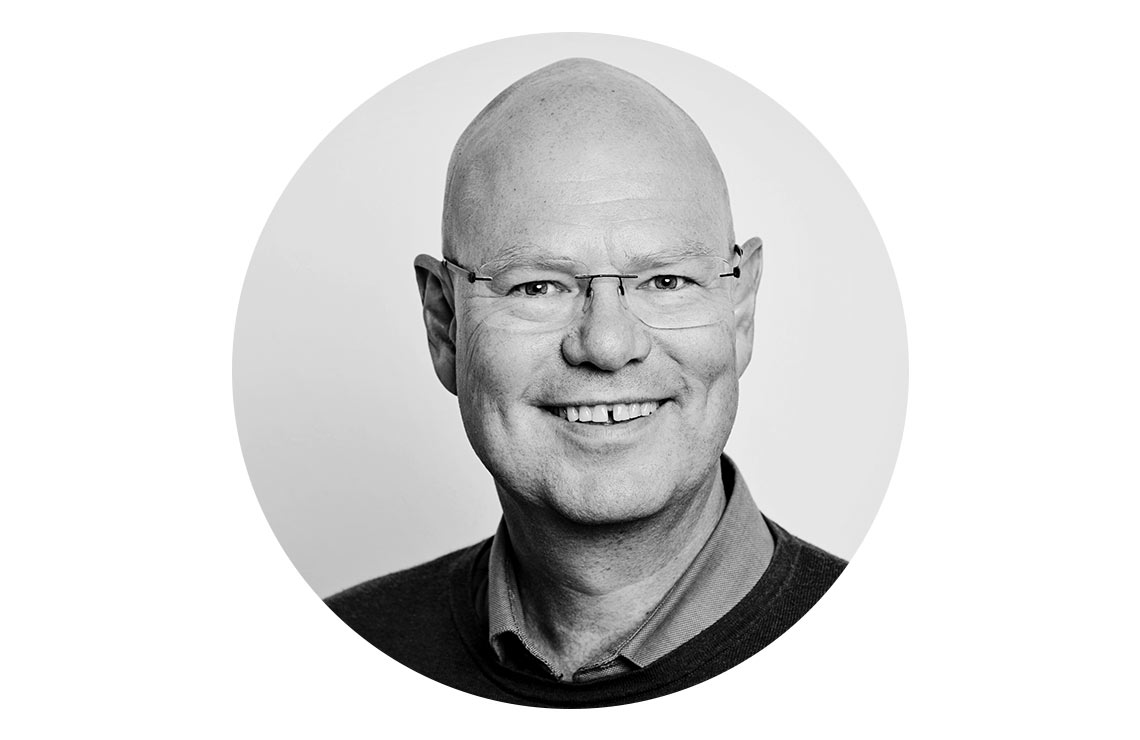
John Einar Sandvand
Communications Manager for Product & Tech
Years in Schibsted: 28
Six battles news media must win

Six battles news media must win
With news brands in strong positions and more than one million digital subscribers, it’s time to take on a new ambitious strategy for Schibsted’s news media. Siv Juvik Tveitnes, Head of the media division in Schibsted, defines six must-win battles on the road ahead.
For the last few decades, the media industry has faced enormous challenges, struggling to find its way in a new digital landscape. We have undergone – and are continuing to undergo – a digital transformation. The way in which people consume news and content has radically changed. Information flows are increasing exponentially, and our business models and ways of working have changed in step with new trends. This has all been very challenging, and like many others, Schibsted has made many difficult decisions along the way. It’s been a time of reorganisations, cost cutting, mergers and concern about the future.
But today the picture looks different in Schibsted. All the work we put in, all the reorganisations we initiated, along with the increased pace of innovation and development, have borne fruit. We have achieved our goal of sustainable digital media. In September 2021, we reached one million digital subscribers. And the willingness to pay for news is growing in both Norway and Sweden.
A strong digital trend during the pandemic has also revealed a future in which digital revenues grow more than print revenues fall. So, as we move forward, we are able to focus on growth. And to operationalise this ambition, we have defined six must-win battles.
1. Strengthen our journalistic positions
Our news media brands have significant growth potential, but this requires us to invest and innovate. The competition is hard, and our users have high demands when it comes to quality, credibility and user experience. We must continue to strengthen their loyalty and confidence in us.
At the same time, our brands hold different positions. For instance, for VG and Aftonbladet, it’s about being the most important news destination. While Aftenposten aims for a more explanatory role, and Svenska Dagbladet strives to deliver on a smart news experience. Bergens Tidende and Stavanger Aftenblad are investing a lot of resources in strengthening their respective regional positions, just as our local news brands aim to strengthen their local positions. E24 has the position as Norway’s biggest online destination for financial and business news. And the news service Omni’s desired position is to be number one among the forward-leaning news consumers in Sweden.
The common denominator is that we all depend on a visionary product strategy to stay ahead when it comes to meeting the needs of tomorrow’s media users – at the same time as we meet their needs today.
As a response to this, our product organisation has developed a vision, one that is spot on: “To be a natural part of everyone’s daily habits”.
2. Challenge for new positions
We have significant potential when it comes to creating new media products and services that can bring even more value to people’s lives. The media landscape is characterised by consolidations, and these create opportunities to explore new products and revenues – both inside and outside our core business.
Our investment in the podcast platform Podme is one example of a non-traditional media product we are focusing on in several countries. It has moved from being a venture investment in Schibsted to becoming part of our core business. We will pursue our interest in companies and brands where we believe we can be good owners. It’s natural for us to focus initially on the Nordic region. But in Schibsted anything is possible…
3. Grow subscription with smarter offerings
The level of willingness to pay for journalism is high in Norway and Sweden. In these countries we have been pioneers in the market. We have been driving this trend through our high-quality journalism, as well as our continual work to add value to our products and the user journey. The growth potential remains great in terms of winning more customers and developing smarter offerings across our brands. Moving forward, we will grow in three ways:
Through our existing brands, as we have done in the past.
Through a bigger and broader portfolio of brands, such as Podme and our acquisition of the outdoor recreation magazine Fri Flyt. More investments will follow.
Through a more interwoven portfolio. We must create seamless user journeys that meet people’s needs. We will continue to experiment in bundling products. The initiative in E24 is a good example of how we can reach a much wider audience and broaden our content, by offering E24 along with our other brands.
4. Reinforce our premium advertising position
Competition in the advertising market is fierce. The pandemic posed a major challenge for us and for advertisers, but the outlook is much brighter, and activity in the market is picking up. We believe that we still are – and will continue to be – a strong alternative to the global giants, and we will continue to invest in – and strengthen – our current premium advertising position. To strengthen our position, we must have control of the regulatory changes that will affect how we and others, not least the tech giants, run our advertising businesses.
We must also invest in first-hand, high-quality data, which we obtain by increasing the number of logged-in users. If we succeed in that, we will continue to have a major competitive advantage. Developing our effect metrics, exploring e-commerce opportunities, and growing our content marketing business are other areas that will be particularly important in the time ahead.
5. Grow our people and attract talent
The competition for talent is intense but extremely important. We must be in a position where we can attract the best people while developing those we already have. We are now entering new and unexplored territory, where hybrid jobs and more flexibility will be the norm. We don’t know how this will affect collaboration, culture and loyalty. Still, we must have a clear plan in place for recruitment, competence development, leadership development and career planning.
Diversity and inclusion are also high on our agenda, in the whole of Schibsted and across society. We have improvement potential that we take very seriously.
6. Improve our data and tech foundation
Our growth strategy is completely dependent on us using data in more sophisticated ways – and continually striving to improve the user experience. This applies to advertising, subscriptions and product development for all our brands, both individually and across. We also see a lot of untapped potential in the use of technology such as artificial intelligence.
It’s vital that we succeed in getting as many people as possible to log into our products. Access to data on our users is vital for creating even more relevant new products, such as through personalisation. People use our products in different ways, and we need to take this into account.
Our common platforms, the editorial, subscription and advertising platforms, provide us with a solid competitive advantage and ability to scale. Continuous development of these platforms is also vital to achieve further growth.
The ability to finally stand strong and look ahead with another, ambitious perspective serves as a powerful source of motivation for all of us working within News Media in Schibsted. We do have world-class news media brands. We have an amazing organisation of talented people who help ensure that we can continually develop quality products and services, ones that meet our users’ needs.
The fact that our strong news media brands also are part of a larger Schibsted family, with a solid financial position that is willing to invest – not only within our core areas, but also to look at opportunities beyond that – gives us the best starting point and the best conditions we’ve had for many years to reach new ambitions and new heights.
Most importantly this gives us the muscle power to pursue our societal mission to have a broad reach and to strengthen democracy through free and independent high-quality journalism. Something that is more important than ever.

Siv Juvik Tveitnes
EVP News Media
Years in Schibsted: 15
Six drivers for change

Six drivers for change
We live in a new climate in which disruption is normal. Together with Amy Webb and the Future Today Institute, Schibsted has identified six drivers for change that will specifically influence our future.
Changing demographics and society
Significant societal and cultural change will shift the face of the consumer and the cultural environment. Migration, combined with falling birth rates, are changing the Nordics. Immigration, while necessary to sustain population levels, is challenging countries to fully integrate these new residents. Language barriers are growing.
In addition, younger generations are influencing more purchase decisions and setting new expectations for experiences that seamlessly flow from physical to digital and back. Gen Z is entering the workforce with a weaker economic outlook and concerns about their ability to own their home. This will impact consumption patterns and workplace cultures.
Changing consumer expectations may force Nordic companies to evaluate their business models across the core industries, while the changing political environment may shift regulation in the markets where they operate.
Significant trends: New generations of consumers, increased migration, globally eroding trust in media, sustainability.
Artificial intelligence advancements
Artificial intelligence is changing the value we can extract from data and the nature of our interactions. AI represents the third era of computing and is used across most industries. The convergence of ground-breaking research, business use cases, the explosive growth of data, and improvements in computing power and storage are enabling advances in AI. The global artificial intelligence market is expected to grow at a CAGR of 42.2 percent from 2021 to 2027.
AI represents significant opportunity and serious risk in the forms of automating content versioning, deploying new forms of media and entertainment, developing shared efficiencies across portfolio brands and the potential spread of misinformation. AI advancements may create new content opportunities, but it also forces companies to determine how to address a growing category of experiences that aren’t “real” or “fake”, but generated, manipulated or synthetic. AI greatly impacts the future of media.
Significant trends: GPT-3 (advanced language models) evolution, synthetic media applications, new realities (AR/VR/XR), algorithm marketplaces.
Move to distributed consumption
From cars to clothes to entertainment, consumers are turning to access over ownership. Distributed consumption models are shifting the power dynamics in the relationship between companies and customers. As consumers move away from ownership of assets, subscription models enable them to buy access but at a cost; when subscriptions lapse, users don’t retain anything.
Governments and consumers are driving adoption of the circular economy. Beyond sustainability, these models can drive deeper engagement with customers and help a brand gain greater control over the resale market for its products. Significant growth and investment in the area moving products away from classified-like marketplaces and into branded resale experiences. Fractional ownership creates opportunities for affordable stakes in assets that would otherwise be out of reach for many, but these markets are driving asset prices higher as they spark speculative investing.
Significant trends: subscription models/D2C economy, subscription models for news, circular economy, fractional ownership.
Financial, contract and verification technologies
The basis for trust in interactions is shifting –including how we authenticate who we are and verify what we buy. Technology is facilitating trusted interactions through decentralisation and reducing the trust required between parties. This shifts trust to the technology structure itself. Trust in brands may only come if they carry a verification seal backed by data we can inspect. Consumers will expect companies to adopt more of these technologies to reduce friction and make transparent information about product origin.
Despite the growth in platforms and apps, the promise of decentralisation is not being realised globally. Services are beginning to use geo-blocking to limit access and prevent conflicts with sanctioned countries. A digital divide is growing — who you are and where you are dictates what technology you can use.
By shaping the future of interactions, these technologies create opportunities for new services along with significant early-mover advantages due to the investment and network effects required.
Significant trends: Purpose-built blockchains, smart contracts, decentralised social networks, verification and provenance.
Optimising decisions and discovery
Algorithms are changing the way we search for information, make decisions, and even discover new sources and ideas. New technologies and trends will impact how consumers find media and services — and how they behave once that happens.
Changes in decision-making and discovery could disintermediate companies like Schibsted from their customers. This is an area of vulnerability for Schibsted – and Scandinavia in general – when compared with global tech players who are driving innovation in these trends. At the same time, there are meaningful opportunities for anyone who can successfully identify a new product.
Search and discovery define the first steps in a customer journey. As customers adopt new ways of finding information and making decisions, gatekeepers will have greater influence on that path and may exclude other brands as sources or their sites as destinations.
Significant trends: Natural language search, non-text search, personalised versioning in news, one-to-few publishing.
Growth of enabling technologies
Digital infrastructure that demonstrates an understanding of the customer and eliminates friction is shifting expectations. Enabling technologies drive radical innovation and new capabilities. Circuit boards, communications satellites and the internet are three key enabling technologies that gave rise to computers and smartphones, the entertainment industry and three of the most valuable companies in the world (Apple, Microsoft and Amazon).
In the coming decade, a host of new enabling technologies will shift the consumer and enterprise markets once again, as 5G and 6G networks are deployed, supply chains and retail operations are digitised and climate change forces the fast adoption of smart grid management.
These technologies create foundational capabilities for all digital businesses, but tech players may have a first-mover advantage and ultimately disintermediate smaller players from customers.
Significant trends: Emerging consumer devices, next-gen wireless, automated logistics, smart grid management.

Anders Grimstad
Head of Tech Experiments
Years in Schibsted: Almost 5

Zuzanna Zygadlo-Stenberg
Technology Strategy Lead
Years in Schibsted: 1.5

